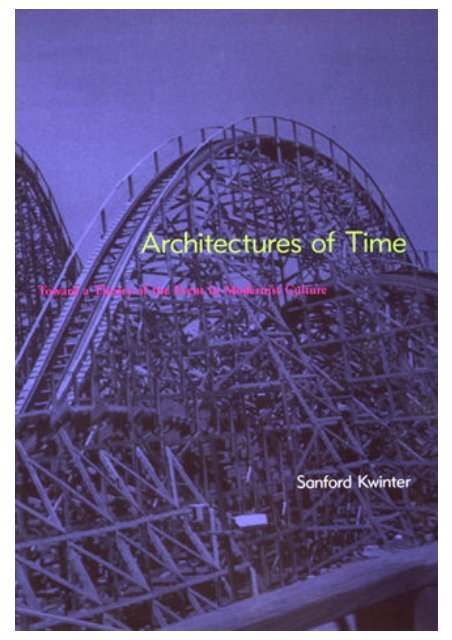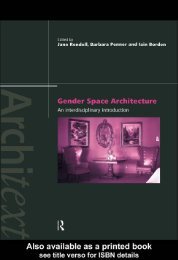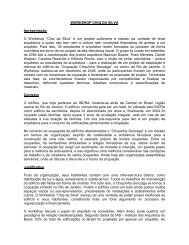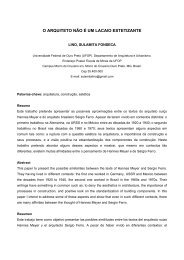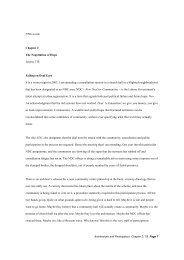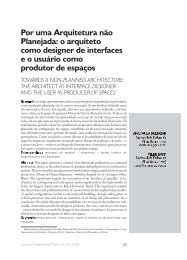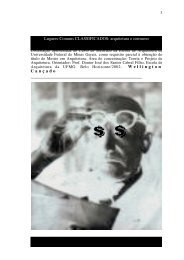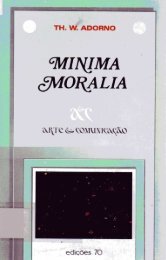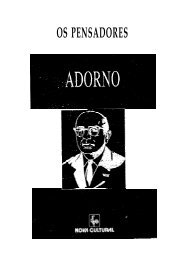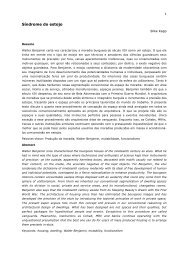Architectures of Time Toward a Theory of the Event in Modernist ...
Architectures of Time Toward a Theory of the Event in Modernist ...
Architectures of Time Toward a Theory of the Event in Modernist ...
Create successful ePaper yourself
Turn your PDF publications into a flip-book with our unique Google optimized e-Paper software.
<strong>Architectures</strong> <strong>of</strong> <strong>Time</strong><br />
<strong>Toward</strong> a <strong>Theory</strong> <strong>of</strong> <strong>the</strong> <strong>Event</strong> <strong>in</strong> <strong>Modernist</strong> Culture<br />
SANFORD KWINTER<br />
The MIT Press<br />
Cambridge, Massachusetts<br />
London, England
First MIT Press paperback edition, 2002<br />
© 2.001 Massachusetts Institute <strong>of</strong> Technology<br />
All rights reserved. No pace <strong>of</strong> this book may be reproduced <strong>in</strong> any form<br />
or by any electronic or mechanical means (<strong>in</strong>clud<strong>in</strong>g photocopy<strong>in</strong>g,<br />
record<strong>in</strong>g, or <strong>in</strong>formacion storage and retrieval) without permission <strong>in</strong><br />
writ<strong>in</strong>g from <strong>the</strong> publisher.<br />
This book was set <strong>in</strong> Adobe Garamond<br />
by Graphic Composition, Inc., :A<strong>the</strong>ns, Georgia<br />
and pr<strong>in</strong>ted and bound <strong>in</strong> <strong>the</strong> United States <strong>of</strong> America.<br />
Library <strong>of</strong> Congress Catalog<strong>in</strong>g-<strong>in</strong>-Publicacion Data<br />
Kw<strong>in</strong>ter, Sanford.<br />
Architects <strong>of</strong> time: toward a <strong>the</strong>ory <strong>of</strong> <strong>the</strong> event <strong>in</strong> modernist culture / Sanford Kw<strong>in</strong>ter.<br />
p. cm.<br />
Includes bibliographical references and <strong>in</strong>dex.<br />
ISBN 0-262-11260-4 (hc: alk. paper), 0-262-61181-3 (Pb)<br />
1. Modern movement (Architecture) 1. Tide.<br />
NA628.M63 K89 200 I<br />
724'.6-dc21<br />
10 9 8 7 6 5 4 3<br />
00-045085
<strong>Architectures</strong> <strong>of</strong> <strong>Time</strong>
1.1<br />
Surfer, 1960s. Photo: Dr. Don James.
I<br />
The Complex and <strong>the</strong> S<strong>in</strong>gular<br />
Reality . .. is a perpetual becom<strong>in</strong>g.<br />
It makes or remakes itself, but it is<br />
never someth<strong>in</strong>g made.<br />
-HENRI BERGSON
WHAT WOULD IT CHANGE <strong>in</strong> our arts, our sciences, and our technics if time<br />
were conceived as someth<strong>in</strong>g real? Though over a century has passed s<strong>in</strong>ce <strong>the</strong> first<br />
tremors <strong>of</strong> this fundamental question began to mal{e <strong>the</strong>mselves felt <strong>in</strong> philosophical<br />
and scientific debate <strong>in</strong> <strong>the</strong> Western world, <strong>the</strong> problem stubbornly rema<strong>in</strong>s,<br />
ei<strong>the</strong>r largely <strong>in</strong>tractable or willfully ignored. What is it about time's<br />
relentless fluidity, its irreducible materiality, that <strong>the</strong> modern m<strong>in</strong>d f<strong>in</strong>ds so impossible-or<br />
repellent-to th<strong>in</strong>k?<br />
"But Western Be<strong>in</strong>g," <strong>the</strong> voices <strong>of</strong> our <strong>in</strong>stitutions will protest, "is time, and<br />
has been so s<strong>in</strong>ce <strong>the</strong> very dawn <strong>of</strong> modernity"-s<strong>in</strong>ce <strong>the</strong> advent <strong>of</strong> rationalized<br />
account<strong>in</strong>g practices, <strong>the</strong> discovery <strong>of</strong> universal mechanical laws and constants,<br />
<strong>the</strong> <strong>of</strong> systematic techniques for govern<strong>in</strong>g populations, <strong>the</strong> rise <strong>of</strong>humarustic<br />
discipl<strong>in</strong>es and experimental method, <strong>the</strong> birth <strong>of</strong> <strong>the</strong> Cartesian or modern<br />
"self." But <strong>the</strong> forms <strong>of</strong> time expressed <strong>in</strong> <strong>the</strong>se seem<strong>in</strong>gly disparate historical<br />
developments are not, strictly spealdng, "real" at all, but only chimeras <strong>of</strong> an<br />
emerg<strong>in</strong>g and very specific <strong>in</strong>strumental culture; <strong>the</strong>y are, <strong>in</strong> a word, abstractions-<strong>in</strong>genious<br />
tools contrived to distribute <strong>the</strong> senseless procession <strong>of</strong> events<br />
<strong>in</strong> nature with<strong>in</strong> an external, th<strong>in</strong>kable space <strong>of</strong> measure, management, and<br />
mastery.<br />
But nature itself is wild, <strong>in</strong>different, and accidental; it is a ceaseless pullulation<br />
and unfold<strong>in</strong>g, a dense evolutionary plasma <strong>of</strong> perpetual differentiation and <strong>in</strong>novation.<br />
Each th<strong>in</strong>g, it may be said, changes and arrives <strong>in</strong> time, yet <strong>the</strong> posture<br />
<strong>of</strong> externality that permits precise measure and perfect mastery can be struck and<br />
assumed only <strong>in</strong> space; one must first withdraw oneself from <strong>the</strong> pr<strong>of</strong>use, organic<br />
flux <strong>in</strong> which th<strong>in</strong>gs are given, isolate discrete <strong>in</strong>stants as projected frozen sections,<br />
and <strong>the</strong>n <strong>in</strong>terpolate abstract laws like so much mortar to rejo<strong>in</strong> <strong>the</strong>se sections<br />
from <strong>the</strong> new perspective. But <strong>the</strong> very gesture that carries thought away<br />
from <strong>the</strong> "event" and toward <strong>the</strong> "th<strong>in</strong>g" abstracts and spatializes time <strong>in</strong> <strong>the</strong> act<br />
<strong>of</strong> <strong>in</strong>strument ali z<strong>in</strong>g it; it subjugates <strong>the</strong> cont<strong>in</strong>gency and volatility <strong>of</strong> time by reconstitut<strong>in</strong>g<br />
it external to phenomena as a f<strong>in</strong>itude and a regularity: it becomes a<br />
technique <strong>of</strong> measurement embodied <strong>in</strong> 'economic axioms and algebraic laws.<br />
Real time is more truly an eng<strong>in</strong>e, however, than a procession <strong>of</strong> images-it is<br />
expressed only <strong>in</strong> <strong>the</strong> concrete, plastic medium <strong>of</strong> duration. <strong>Time</strong> always expresses<br />
itself by produc<strong>in</strong>g, or more precisely, by draw<strong>in</strong>g matter <strong>in</strong>to a process <strong>of</strong> becom<strong>in</strong>g-ever-different,<br />
and to <strong>the</strong> product <strong>of</strong> this becom<strong>in</strong>g-ever-different-to this <strong>in</strong>-<br />
4<br />
CHAPTER I
uilt wildness-we have given <strong>the</strong> name novelty. Yet exactly what is novelty, and<br />
from where does it come? What might th<strong>in</strong>k<strong>in</strong>g about it make possible <strong>in</strong> this<br />
world, <strong>in</strong> this civilization whose deepest religious and philosophical beliefs, and<br />
whose social and political <strong>in</strong>stitutions, are committed precisely to reduc<strong>in</strong>g, elid<strong>in</strong>g,<br />
or deny<strong>in</strong>g <strong>the</strong> cont<strong>in</strong>ual mutations and <strong>in</strong>sistent mischievousness <strong>of</strong> unmasterable<br />
<strong>in</strong>novation and <strong>the</strong> wild becom<strong>in</strong>g that drives it?<br />
We might say that novelty is simply a modality, a vehicle, by or through<br />
someth<strong>in</strong>g new appears <strong>in</strong> <strong>the</strong> world. It is that ever-fresh endowment that affirms<br />
a radical <strong>in</strong>commensurability between what happens at any given <strong>in</strong>stant and<br />
what follows. What has made it a problem for thought-and its problematic nature<br />
predates our own modernity, reach<strong>in</strong>g back to <strong>the</strong> time <strong>of</strong> <strong>the</strong> Greeks-is <strong>the</strong><br />
way it is seen to <strong>in</strong>troduce a corrupt<strong>in</strong>g element or impure pr<strong>in</strong>ciple <strong>in</strong>to <strong>the</strong> prist<strong>in</strong>e<br />
and already full world <strong>of</strong> "Creation." The <strong>of</strong>fend<strong>in</strong>g element here is no o<strong>the</strong>r<br />
than <strong>the</strong> pr<strong>in</strong>ciple <strong>of</strong> change, for <strong>in</strong> cosmological thought, change is ei<strong>the</strong>r recognized<br />
as a first pr<strong>in</strong>ciple or not accepted to exist at all. l All change is change over<br />
time; no novelty appears without becom<strong>in</strong>g, and no becom<strong>in</strong>g without novelty.<br />
But more important, sett<strong>in</strong>g out to th<strong>in</strong>k about novelty, or "<strong>the</strong> new," might provide<br />
a way to revive our presendy atrophied capacities <strong>of</strong> act<strong>in</strong>g-practically, ethically,<br />
and politically-<strong>in</strong> this world, a world whose scope and complexity have<br />
effectively passed beyond grasp or measure. It is, <strong>in</strong> o<strong>the</strong>r words, our capacity actively<br />
to engage <strong>the</strong> processes <strong>of</strong> contemporary reality, a capacity that by most accounts<br />
is today so menac<strong>in</strong>gly at stake, that might itself be brought <strong>in</strong>to relief<br />
here, grasped, <strong>in</strong>terrogated, and perhaps transformed.<br />
The era <strong>of</strong> cultural production we are travers<strong>in</strong>g is unarguably one <strong>of</strong> impoverishment<br />
and mediocrity-<strong>in</strong> art, philosophy, literature, even architecture,<br />
though to a lesser extent-an era whose <strong>in</strong>augural segment was marked by<br />
reaction, an era <strong>in</strong> which <strong>in</strong>novation itself seemed all but to have collapsed and<br />
which neurotically lauded itself for a "criticality" that was litde more than <strong>the</strong><br />
impulse, which would normally discharge itself through <strong>the</strong> assembl<strong>in</strong>g and <strong>in</strong>vention<br />
<strong>of</strong> new capacities, ensembles, and functions, become corrupted and<br />
turned <strong>in</strong>ward as "critique." In <strong>the</strong> doma<strong>in</strong> <strong>of</strong> architecture-<strong>the</strong> first to have declared<br />
its "postmodern" emancipation from avant-gardist modernity-this tendency<br />
to mediocrity was expressed, and only barely masked, by a decade <strong>of</strong><br />
submission to <strong>the</strong> cult <strong>of</strong> historical styles, and subsequently to myriad, but <strong>of</strong>ten<br />
hollow neo- and antimodernist <strong>in</strong>tellectual postures ("strategies" such as<br />
1 This statement applies <strong>of</strong> course to systematic philosophy and classical science, not to <strong>the</strong><br />
cont<strong>in</strong>ually self-updat<strong>in</strong>g pseudo-axiomatics <strong>of</strong> Christian <strong>the</strong>ology and Western capitalism.<br />
THE COMPLEX AND THE SINGULAR 5
collage, deconstruction, and <strong>the</strong> crypto-formalist revivals <strong>of</strong> computer-aided<br />
model<strong>in</strong>g). Though <strong>the</strong> parochialism <strong>of</strong> <strong>the</strong>se especially recent developments is<br />
<strong>of</strong>ten obscured by <strong>the</strong> virtuosity <strong>of</strong> <strong>the</strong>ir results, <strong>the</strong>y have never managed to<br />
hide <strong>the</strong>ir fundamental aimlessness, <strong>the</strong> <strong>in</strong>evitable result <strong>of</strong> cultures whose <strong>in</strong>tellectual<br />
activity has become severed from its foundations <strong>in</strong> social, historical,<br />
and economic life.<br />
Yet a return to <strong>the</strong> "critical" modes <strong>of</strong> <strong>the</strong> preced<strong>in</strong>g period is no acceptable solution.<br />
For it is <strong>in</strong> periods like those that architects and artists, as well as writers<br />
and th<strong>in</strong>kers, are able to see <strong>the</strong> world only <strong>in</strong> <strong>the</strong> terms <strong>of</strong> a (real or imag<strong>in</strong>ed)<br />
oppressor's conventions-<strong>in</strong>deed <strong>of</strong> conventions tout court-for <strong>the</strong>y have lost<br />
<strong>the</strong> thread, one might say, <strong>of</strong> <strong>the</strong>ir own reality or perspective, <strong>the</strong>ir own politic,<br />
<strong>the</strong>ir own "world-build<strong>in</strong>g." Critique is always a critique (and <strong>the</strong>refore an elaboration)<br />
<strong>of</strong> what exists already, implicitly reconstitut<strong>in</strong>g this preexistence as a<br />
static th<strong>in</strong>g (both <strong>in</strong> its referential and representational forms). Clearly all critique<br />
is <strong>of</strong> representations and is, as many <strong>of</strong> its own most rigorous practitioners have<br />
claimed, at bottom no more than an elaborate re-representation. But what concerns<br />
us here is <strong>the</strong> concept <strong>of</strong> time that one f<strong>in</strong>ds bound up <strong>in</strong> <strong>the</strong>se wedded practices<br />
<strong>of</strong> critique and representation. What type <strong>of</strong> <strong>in</strong>tervention do <strong>the</strong>se two<br />
practices actively effect <strong>in</strong> <strong>the</strong> world, and what type do <strong>the</strong>y passively imply?<br />
The two relationships-between representation and reality on one hand, and<br />
critique and representation on <strong>the</strong> o<strong>the</strong>r-may be understood accord<strong>in</strong>g to <strong>the</strong><br />
classical morphogenetic model that is determ<strong>in</strong>ed by <strong>the</strong> relationship <strong>of</strong> <strong>the</strong> possible<br />
to <strong>the</strong> real I use <strong>the</strong> technical term "morphogenesis" here <strong>in</strong> no gratuitous<br />
sense, but because it is precisely <strong>the</strong> problem <strong>of</strong> "<strong>the</strong> emergence and evolution <strong>of</strong><br />
form" that I am propos<strong>in</strong>g to discuss, and because it is precisely this problem that<br />
is <strong>in</strong>disputably at <strong>the</strong> heart <strong>of</strong> all formal aes<strong>the</strong>tic practice <strong>in</strong> general, and design<br />
practice <strong>in</strong> particular. 2<br />
How does one characterize <strong>the</strong> morphogenetic model <strong>of</strong> <strong>the</strong> possible <strong>in</strong> relation<br />
to <strong>the</strong> real? To beg<strong>in</strong>, "possible" f<strong>in</strong>ds itself <strong>in</strong>variably placed <strong>in</strong> opposition to<br />
"real" as if it were some type <strong>of</strong> earlier stage; it has on its own, <strong>the</strong>refore, no reality<br />
<strong>in</strong> <strong>the</strong> strict sense, but takes this on only at a later stage, through <strong>the</strong> process <strong>of</strong><br />
realiz<strong>in</strong>g itsel£ How does it do this? Two controll<strong>in</strong>g rules or operators must <strong>in</strong>-<br />
2 The term "formal" is used here not <strong>in</strong> <strong>the</strong> poor sense as <strong>in</strong> "formalistic," but <strong>in</strong> reference to<br />
<strong>the</strong> largely unthought dimension <strong>of</strong> all active pattern<strong>in</strong>g processes <strong>in</strong> <strong>the</strong> universe. compris<strong>in</strong>g<br />
l<strong>in</strong>guistic. social. political. and biological behaviors and forms. <strong>in</strong> addition to aes<strong>the</strong>tic<br />
ones.<br />
6<br />
CHAPTER I
tervene here to relate <strong>the</strong> two states or realms: The first is resemblance, <strong>the</strong> second<br />
limitation. 3 Resemblance, because what is real always conforms to, or matches, <strong>the</strong><br />
image <strong>of</strong> <strong>the</strong> possible-<strong>the</strong> possible presents <strong>the</strong> preexist<strong>in</strong>g image <strong>of</strong> <strong>the</strong> real<br />
whose attractive forces realize it. The possible-though it is but a phantom entity-is<br />
none<strong>the</strong>less a true and faithful copy. Second, limitation, because although<br />
anyth<strong>in</strong>g whatever can exist as a "possible" (a phantom or image) clearly<br />
not everyth<strong>in</strong>g that is possible can be realized. Were it <strong>the</strong> case, <strong>the</strong> world would<br />
become saturated <strong>in</strong> a clamor<strong>in</strong>g <strong>in</strong>stant and historical time would be annihilated<br />
altoge<strong>the</strong>r. Everyth<strong>in</strong>g would not only happen at once, but would <strong>in</strong>deed already<br />
have "happened."<br />
To <strong>the</strong>se two operators <strong>of</strong> resemblance and limitation, <strong>the</strong>n, someth<strong>in</strong>g<br />
clearly must be added, someth<strong>in</strong>g that actively filters and constra<strong>in</strong>s what can<br />
pass <strong>in</strong>to reality. Here we f<strong>in</strong>d <strong>the</strong> only trace <strong>of</strong> a time-pr<strong>in</strong>ciple borne by this<br />
model: Someth<strong>in</strong>g divides <strong>in</strong>to stages <strong>the</strong> pass<strong>in</strong>g <strong>of</strong> preformed phantom<br />
images <strong>in</strong>to concrete reality. Reality, accord<strong>in</strong>g to this model, would still be<br />
noth<strong>in</strong>g but a picture <strong>of</strong> possibility repeated, and <strong>the</strong> world <strong>of</strong> possibility would<br />
be no more than an unchang<strong>in</strong>g storehouse <strong>of</strong> images exist<strong>in</strong>g from time immemorial.<br />
This <strong>the</strong>ory <strong>of</strong> appearance or morphogenesis supposes a sad and conf<strong>in</strong><strong>in</strong>g<br />
world already formed and given <strong>in</strong> advance. Yet this static view <strong>of</strong> th<strong>in</strong>gs has<br />
dom<strong>in</strong>ated nearly all aspects <strong>of</strong> Western culture from <strong>the</strong> time <strong>of</strong> <strong>the</strong> Eleatics,<br />
though most significantly throughout its modern scientific culture. Accord<strong>in</strong>g<br />
to Henri Bergson, this fallacy-that <strong>the</strong>re exists a "realm <strong>of</strong> possibility" underly<strong>in</strong>g<br />
<strong>the</strong> world <strong>of</strong> actuality-is <strong>the</strong> one upon which Western metaphysics is<br />
based. Both <strong>the</strong> deep-seated mechanism <strong>of</strong> our scientific traditions and <strong>the</strong> implicit<br />
f<strong>in</strong>alism <strong>of</strong> our <strong>the</strong>ological, historical, and political traditions f<strong>in</strong>d <strong>the</strong>ir<br />
roots <strong>in</strong> this fallacy.<br />
It is through <strong>the</strong> development <strong>of</strong> this argument that <strong>the</strong> problem <strong>of</strong> novelty<br />
talces on its full importance. For <strong>the</strong> very same pr<strong>in</strong>ciple that "corrupts," transforms,<br />
and dim<strong>in</strong>ishes Forms, evolv<strong>in</strong>g <strong>the</strong>m toward disuse, decrepitude, and disappearance,<br />
also gives, produces, and creates. No object <strong>in</strong> nature-be it organic,<br />
3 See Henri Bergson, "The Possible and <strong>the</strong> Real," <strong>in</strong> The Creative M<strong>in</strong>d (New York: Philosophical<br />
Library, 1946), Introduction to Metaphysics (New York: Philosophical Library,<br />
1961); and Gilles Deleuze, Difftrence et repetition (Paris: PUF, 1968) pp. 272-27'), Ie<br />
Bergsonisme (Paris: PUF, 1968), chap. '). See also <strong>the</strong> arguments <strong>of</strong> Alfred North Whitehead<br />
concern<strong>in</strong>g <strong>the</strong> "Fallacy <strong>of</strong> Misplaced Concreteness," <strong>in</strong> Science <strong>in</strong> <strong>the</strong> Modern World (New<br />
York: Macmillan, 192'), chaps. 3 and 4.<br />
THE COMPLEX AND THE SINGULAR 7
or entirely abstract or immaterial such as an idea, a desire, or a function-escapes<br />
<strong>the</strong> perpetual onslaught <strong>of</strong> differentiation accord<strong>in</strong>g to which<br />
objects are cont<strong>in</strong>ually becom<strong>in</strong>g different from <strong>the</strong>mselves, undergo<strong>in</strong>g transformation.<br />
It is true, that change may and ought to be seen as a type <strong>of</strong> movement-<strong>the</strong><br />
flow <strong>of</strong> matter through time-but even <strong>the</strong> simplest mechanical<br />
movement <strong>of</strong> <strong>the</strong> classical translational. type resisted scientific and philosophical<br />
assimilation until very late <strong>in</strong> our history. For "transformation" and "<strong>in</strong>vention,"<br />
I wish to show, are also tw<strong>in</strong> and <strong>in</strong>separable functions. Both are qualityproduc<strong>in</strong>g<br />
processes that describe <strong>the</strong> coherent flow <strong>of</strong> matter through time, and<br />
it is time, and only time, that makes <strong>the</strong> new both possible and necessary.4<br />
To th<strong>in</strong>k <strong>in</strong> this way, however, means develop<strong>in</strong>g a radically different <strong>the</strong>ory<br />
and regime <strong>of</strong> morphogenesis. The so-called emergence and evolution <strong>of</strong> form<br />
will no longer follow <strong>the</strong> classical, eidetic pathway determ<strong>in</strong>ed by <strong>the</strong> possible<br />
and <strong>the</strong> real. 5 Ra<strong>the</strong>r, it will follow <strong>the</strong> dynamic and uncerta<strong>in</strong> processes that<br />
characterize <strong>the</strong> schema that l<strong>in</strong>ks a virtual component to an actual one. What is<br />
most important to understand here is that unlike <strong>the</strong> previous schema where <strong>the</strong><br />
"possible" had no reality (before emerg<strong>in</strong>g), here <strong>the</strong> virtual, though it may yet<br />
have no actuality, is none<strong>the</strong>less already fully real. It exists, one might say, as a<br />
fteedifference or s<strong>in</strong>gularity, not yet comb<strong>in</strong>ed with o<strong>the</strong>r differences <strong>in</strong>to a complex<br />
ensemble or salient form. What this means is that <strong>the</strong> virtual does not have<br />
to be realized, but only actualized (activated and <strong>in</strong>tegrated); its adventure <strong>in</strong>volves<br />
a developmental passage from one state to ano<strong>the</strong>r. The virtual is ga<strong>the</strong>red,<br />
selected-let us say <strong>in</strong>carnated-it passes from one moment-event (or<br />
complex) <strong>in</strong> order to emerge-differently, .uniquely-with<strong>in</strong> ano<strong>the</strong>r. Indeed<br />
<strong>the</strong> actual does not resemble <strong>the</strong> virtual, as someth<strong>in</strong>g preformed or preexist<strong>in</strong>g itself.<br />
The relation <strong>of</strong> <strong>the</strong> virtual to <strong>the</strong> actual is <strong>the</strong>refore not one <strong>of</strong> resemblance<br />
but ra<strong>the</strong>r <strong>of</strong> difference, <strong>in</strong>novation, or creation (every complex, or momentevent,<br />
is unique and new). Thus <strong>the</strong> follow<strong>in</strong>g should be clear: realization (<strong>of</strong> a<br />
possible) and creation (through actualization-differentiation) are two <strong>in</strong>tr<strong>in</strong>si-<br />
4 In Creative Evolution, Bergson argues <strong>the</strong> need for a science or "mechanics <strong>of</strong> transformation"<br />
<strong>of</strong> which our "mechanics <strong>of</strong> translation" would become but a particular case (New<br />
York: Henry Holt and Co., 19II), p. 32. Alfred North Whitehead, draw<strong>in</strong>g a similar dist<strong>in</strong>ction,<br />
claimed <strong>in</strong> 1925 that "biology is <strong>the</strong> study <strong>of</strong> larger organisms; whereas physics is<br />
<strong>the</strong> study <strong>of</strong> <strong>the</strong> smaller organisms") (Science <strong>in</strong> <strong>the</strong> Modem World, p. 103). For Whitehead<br />
even <strong>the</strong> physico-chemical world could be understood only <strong>in</strong> terms <strong>of</strong> <strong>the</strong> (prehensive)<br />
"events" it undergoes, and to which it gives place.<br />
5 C£ Bergson's critique <strong>of</strong> Platonic and Aristotelian eidos <strong>in</strong> Creative Evolution, pp. 314-329.<br />
8<br />
CHAPTER I
1.2<br />
Hans Jenny. Kymatic: Wellen und Schw<strong>in</strong>gungen mit ihrer Struktur und Dynamik, 1967.<br />
Basel: Basilius Presse AG.<br />
In <strong>the</strong>se Kymatic images by Hans Jenny, stand<strong>in</strong>g waves are generated by s<strong>in</strong>us tones emitted<br />
across steel plates by crystal oscillators (<strong>in</strong> much <strong>the</strong> same manner as Ernst Chladni's eighteenthcentury<br />
Klangftguren). A mixture <strong>of</strong> sand and superf<strong>in</strong>e lycopodium powder forms <strong>the</strong> outl<strong>in</strong>es<br />
<strong>of</strong> <strong>the</strong> resultant shapes as it is transported across <strong>the</strong> plate suiface <strong>in</strong>to virtual troughs between<br />
<strong>the</strong> more highly activated areas <strong>of</strong> <strong>the</strong> field. One can discern a specific and uniform underly<strong>in</strong>g<br />
pattern or texture "beneath" <strong>the</strong> resultant figure that is a jo<strong>in</strong>t property <strong>of</strong> <strong>the</strong> metallurgy <strong>of</strong> <strong>the</strong><br />
sound<strong>in</strong>g plate and <strong>of</strong> <strong>the</strong> tone that moves through it. This underly<strong>in</strong>g pattern is itself never<br />
reproduced, but rema<strong>in</strong>s virtual The actual pattern (<strong>the</strong> sand-lycopodium figure) always<br />
expresses a variation or development <strong>of</strong> its virtual form-built on <strong>the</strong> template but cont<strong>in</strong>uously<br />
variable and vary<strong>in</strong>g. Both <strong>the</strong> actual and <strong>the</strong> virtual structures are legible <strong>in</strong> <strong>the</strong> same image,<br />
though <strong>the</strong>ir ontological status rema<strong>in</strong>s peifectly dist<strong>in</strong>ct.<br />
THE COMPLEX AND THE SINGULAR 9
cally dist<strong>in</strong>ct and irreducible processes. The first programmatically reproduces<br />
what was already <strong>the</strong>re, formed and given <strong>in</strong> advance, while <strong>the</strong> o<strong>the</strong>r <strong>in</strong>vents<br />
through a cont<strong>in</strong>uous, positive, and dynamic process <strong>of</strong> transmission, differentiation,<br />
and evolution.<br />
r -, The crux lies here: Actualization occurs <strong>in</strong> time and with time, whereas real-<br />
: ization, by limit<strong>in</strong>g itself to <strong>the</strong> mere unfold<strong>in</strong>g <strong>of</strong> what preexists, actually destroys<br />
novelty and annihilates time. In <strong>the</strong> first <strong>in</strong>stance time is real; <strong>in</strong> <strong>the</strong> second<br />
it rema<strong>in</strong>s artificially derived and<br />
In <strong>the</strong><br />
, time is a dynamic and perpetually activated flow, hi-<strong>the</strong>- <strong>the</strong> result ;f<br />
- 'an externally built-up succession <strong>of</strong> static images.<br />
'as -a mechanical process <strong>of</strong> translation 1ixiia o.o.ceanQ:<br />
external to<br />
'ilie with its highlY and<br />
'is<br />
ual <strong>in</strong>stability and <strong>the</strong>refore cre;tion itself, and wedded-to'<br />
<strong>of</strong> time, or one madlematici;;:;;'<br />
Rene Thom, ,<strong>the</strong> ceaseless procession <strong>of</strong> Clearly, if<br />
is real,<br />
<strong>of</strong> morphogenesis (IlOVelty)<br />
time, withfna mobile:i.nd dynamic reality riddled with<br />
discont<strong>in</strong>uities. -------------<br />
\""<br />
Can <strong>the</strong>re, <strong>the</strong>n, be an ethics <strong>of</strong> material culture free from <strong>the</strong> bureaucracy <strong>of</strong><br />
critique, <strong>of</strong> <strong>the</strong> negative, <strong>of</strong> <strong>the</strong> spatial-visual, and <strong>of</strong> <strong>the</strong> static? Can <strong>the</strong>re be a politics<br />
<strong>of</strong> form based on <strong>the</strong> productive, <strong>the</strong> positive, <strong>the</strong> mobile, and <strong>the</strong> new?<br />
Might concepts such as "novelty" and "movement" still be politicized and placed<br />
at <strong>the</strong> heart <strong>of</strong> cultural production? Clearly, <strong>the</strong> concept <strong>of</strong> "new" as it is used here<br />
is deeply <strong>in</strong>debted to modernist philosophies-that is, philosophies that are<br />
bound up chronologically with those same movements whose claim at ano<strong>the</strong>r<br />
level to "newness" is so <strong>of</strong>ten reviled by contemporary critical cultural practices<br />
and <strong>the</strong>ories.' t use such a concept both without apology and without tak<strong>in</strong>g sides<br />
<strong>in</strong> this debate-its purpose is to underscore why it may be <strong>in</strong>terest<strong>in</strong>g and fruitful<br />
to reject <strong>the</strong> very terms and conditions <strong>in</strong> which such a debate is posed.<br />
The late n<strong>in</strong>eteenth-century prescription to remake oneself absoluement mod erne<br />
was <strong>in</strong>separable from a more systematic and generalized historical need to discover-or<br />
to <strong>in</strong>vent at any cost-a pr<strong>in</strong>ciple <strong>of</strong> absolute novelty and a correlative<br />
river <strong>of</strong> time to bear it along. For Nietzsche, <strong>the</strong> punctuated violence <strong>of</strong> <strong>the</strong> Unzeitgemalliche,<br />
or <strong>the</strong> untimely, was wedded to <strong>the</strong> <strong>in</strong>f<strong>in</strong>ite spiral-not circle<strong>of</strong><br />
eternal recurrence, <strong>in</strong> order that <strong>the</strong> Will to Power might circulate freely,<br />
unfettered by <strong>the</strong> sclerosis <strong>of</strong> a false memory ta<strong>in</strong>ted by "morals." Bergson's en-<br />
IO<br />
CHAPTER I
lightened vitalism may certa<strong>in</strong>ly be seen as a development <strong>of</strong> Nietzsche's radical<br />
"biological philosophy," albeit <strong>in</strong> a more temperate, systematic mode. Bergson's<br />
pr<strong>in</strong>ciples <strong>of</strong> an ever-<strong>in</strong>dividuat<strong>in</strong>g elan vital and <strong>of</strong> becom<strong>in</strong>g, both cast and unfolded<br />
with<strong>in</strong> an irreducible actualiz<strong>in</strong>g duration, would resurface nearly a century<br />
later comb<strong>in</strong>ed with those <strong>of</strong> Nietzsche to produce Deleuze's philosophy <strong>of</strong><br />
difference, and Foucault's philosophy <strong>of</strong> power/knowledge and philosophy <strong>of</strong><br />
will. These philosophies each develop <strong>in</strong> <strong>the</strong>ir own way <strong>the</strong> pr<strong>in</strong>ciple <strong>of</strong> a mobile<br />
ground <strong>of</strong> cont<strong>in</strong>uous production <strong>of</strong> <strong>the</strong> real as <strong>the</strong> basis <strong>of</strong> history and life. They<br />
reject <strong>the</strong> static field <strong>of</strong> eidetic Forms and representations as so many sources <strong>of</strong>illusion,<br />
bad faith, or at <strong>the</strong> very least, as hostile to movement and arrest<strong>in</strong>g <strong>of</strong> an<br />
irreducible liv<strong>in</strong>g dynamism that drives existence from with<strong>in</strong>.<br />
To approach <strong>the</strong> problem <strong>of</strong> "<strong>the</strong> new," <strong>the</strong>n, one must complete <strong>the</strong> follow<strong>in</strong>g<br />
four requirements: redef<strong>in</strong>e <strong>the</strong> traditional concept <strong>of</strong> <strong>the</strong> object; re<strong>in</strong>troduce<br />
and radicalize <strong>the</strong> <strong>the</strong>ory <strong>of</strong> time; conceive <strong>of</strong> "movement" as a first pr<strong>in</strong>ciple and<br />
not merely a special, dismissable case; and embed <strong>the</strong>se latter three with<strong>in</strong> an allencompass<strong>in</strong>g<br />
<strong>the</strong>ory and politics <strong>of</strong> <strong>the</strong> "event." This presents us with five areas<br />
<strong>of</strong> <strong>in</strong>terrogation: novelty, <strong>the</strong> object, time, movement, and event. We can consider<br />
<strong>the</strong> problem <strong>of</strong> novelty only by confront<strong>in</strong>g <strong>the</strong> question <strong>of</strong> determ<strong>in</strong>ations or .<br />
causes: What makes someth<strong>in</strong>g new emerge? Where does that which did not exist<br />
before come from? How does it cont<strong>in</strong>ue to persist <strong>in</strong> be<strong>in</strong>g? and especially, What<br />
is its relation to matter?:-for clearly <strong>the</strong> "new" is significant only to <strong>the</strong> degree<br />
that it is concrete, And f<strong>in</strong>ally, how does that which is just a pure difference take<br />
on a body? These questions apply with <strong>the</strong>ir own urgency and specificity to <strong>the</strong><br />
social and perceptual field-<strong>the</strong> realm <strong>in</strong> which objects and architectures <strong>of</strong> all<br />
types are assembled and circulated.<br />
The question <strong>of</strong> <strong>the</strong> object may well be even more complex than <strong>the</strong> previous.<br />
On one side it calls for a systematic <strong>in</strong>vestigation <strong>of</strong> physical <strong>the</strong>ory: What is an<br />
object's relation to <strong>the</strong> space immediately surround<strong>in</strong>g it, to its own component<br />
parts, to <strong>the</strong> o<strong>the</strong>r objects with which it is comb<strong>in</strong>ed; what are <strong>the</strong> forces-both<br />
historical and physical-that traverse it, compose it, and bear it along; and what<br />
are <strong>the</strong> adjacent activities and behaviors it mal
and evolutionary systems and complexity, and <strong>the</strong> more remote question <strong>of</strong> a<br />
"middleness" that is opposed to essential or foundational beg<strong>in</strong>n<strong>in</strong>gs and ends.<br />
(S<strong>in</strong>ce movement can be caused and modified only by o<strong>the</strong>r movements, <strong>the</strong><br />
problem <strong>of</strong> orig<strong>in</strong> and <strong>in</strong>itiation must ei<strong>the</strong>r be reconfigured or pass away.) Next<br />
emerges <strong>the</strong> problem <strong>of</strong> nonl<strong>in</strong>earity and <strong>in</strong>determ<strong>in</strong>acy (what is cautiously referred<br />
to as "determ<strong>in</strong>istic chaos"), understood not only as a heuristic and cosmological<br />
model but also as an ethos. And f<strong>in</strong>ally, <strong>in</strong> <strong>the</strong> "event" it may be possible<br />
to discover a vantage po<strong>in</strong>t from which all action is understood as political <strong>in</strong> <strong>the</strong><br />
positive (i.e., not critical) sense-because after all, <strong>in</strong> both <strong>the</strong> social and subjective<br />
realms, politics is arguably noth<strong>in</strong>g more than <strong>the</strong> production <strong>of</strong> new<br />
possibilities.<br />
'J<br />
What follows will proceed schematically to develop two pathways along which<br />
design thought and practice might move today-pathways that would have as a<br />
role to restore to architecture specifically <strong>the</strong> active, and not merely reactive, role<br />
it once had <strong>in</strong> shap<strong>in</strong>g cultural and social life. This will be done without forgett<strong>in</strong>g<br />
or deny<strong>in</strong>g <strong>the</strong> fundamental fact that is <strong>of</strong>ten seen to hamper social and cultural<br />
activity today: <strong>the</strong> perception that <strong>the</strong> world is f<strong>in</strong>ally composed <strong>of</strong> systems<br />
so extensive, so dense, and so complex that it is no longer a question <strong>of</strong> represent<strong>in</strong>g<br />
<strong>the</strong>m <strong>in</strong> <strong>the</strong>ir totality/ globality-through images, concepts, <strong>the</strong>orems, or<br />
maps, all spatial models that today arguably have fallen <strong>in</strong>to disuse-but ra<strong>the</strong>r<br />
<strong>of</strong> engag<strong>in</strong>g <strong>the</strong>se systems at certa<strong>in</strong> specific and local po<strong>in</strong>ts along <strong>the</strong>ir l<strong>in</strong>es <strong>of</strong><br />
deployment or unfold<strong>in</strong>g. It is as if today one were forced <strong>in</strong>to a new type <strong>of</strong> <strong>in</strong>tellectual<br />
and cultural warfare, forced to accept <strong>the</strong> mobile and shift<strong>in</strong>g nature <strong>of</strong><br />
<strong>the</strong> phenomena that make up our social and political world, and by this same token,<br />
forced to discover with<strong>in</strong> this slippery glacis <strong>of</strong> largely <strong>in</strong>dist<strong>in</strong>ct swells and<br />
flows, all <strong>the</strong> ledges, footholds, friction po<strong>in</strong>ts-<strong>in</strong> short, all <strong>the</strong> subtle asperities<br />
that would permit us to navigate, and negotiate life, with<strong>in</strong> it.<br />
'r The first pathway entails a revision <strong>of</strong> <strong>the</strong> concept <strong>of</strong> <strong>the</strong> object. Here archi-<br />
! tecture may be said to have a natural and privileged role, ow<strong>in</strong>g first to its natural<br />
function as an <strong>in</strong>stitutional, social, and <strong>in</strong>strumental operator (it must not be forgotten<br />
that with<strong>in</strong> every concrete architecture is embedded an abstract <strong>in</strong>stitutional<br />
"mach<strong>in</strong>e"); and second, because once we accept this mach<strong>in</strong>ic role and <strong>the</strong><br />
behavioral (motor) modalities it regulates and entails, it is impossible not to consider<br />
architecture <strong>in</strong> an expanded sense as a technical object, subject to <strong>the</strong> same<br />
rules and dynamics as all o<strong>the</strong>r technological historical development.<br />
The second pathway attempts to conceive <strong>of</strong> movement as a first pr<strong>in</strong>ciplethough<br />
it secondarily both engages <strong>the</strong> <strong>the</strong>ory <strong>of</strong> time (treat<strong>in</strong>g time as someth<strong>in</strong>g<br />
I2<br />
CHAPTER I
eal) and develops a <strong>the</strong>ory and praxis <strong>of</strong> <strong>the</strong> "event." This will be done <strong>in</strong> allusive<br />
adjacency to a body <strong>of</strong> recent developments <strong>in</strong> physics and experimental ma<strong>the</strong>matics-those<br />
propos<strong>in</strong>g <strong>the</strong> use <strong>of</strong> new types <strong>of</strong> geometry (phase space, fractals,<br />
attractor dynamics, scal<strong>in</strong>g), new types <strong>of</strong> algebra (nonl<strong>in</strong>ear equations, recursion,<br />
genetic algorithms), and new types <strong>of</strong> model<strong>in</strong>g tools (pr<strong>in</strong>cipally <strong>the</strong> <strong>in</strong>teractive<br />
cathode ray tube and <strong>the</strong> desktop microcomputerl,<br />
These last developments are particularly important, !first, for hav<strong>in</strong>g reoriented<br />
contemporary science toward <strong>the</strong> consideration <strong>of</strong> dynamical phenomena or dynamical<br />
morphogenesis, t9ward geometries or patterns that are not static but appear<br />
only over time; se.c:ond; for <strong>the</strong>ir role !!1 <strong>the</strong> study <strong>of</strong><br />
study<br />
<strong>of</strong> phenomena no longer <strong>in</strong> analytic isolation but as embedded with<strong>in</strong> a rich and<br />
unstable milieu <strong>of</strong> multiple communicat<strong>in</strong>gfoi-ces and <strong>in</strong>fluences; for<br />
hav<strong>in</strong>g <strong>in</strong>troduced <strong>in</strong>to popular discussion <strong>the</strong> technical concept <strong>of</strong> "s<strong>in</strong>gularities,"<br />
referr<strong>in</strong>g to those critical po<strong>in</strong>ts or moments with<strong>in</strong> a system when its qualities<br />
and not just its quantities undergo a fundamental change. It is possible that<br />
this latter development alone-<strong>the</strong> <strong>in</strong>corporation <strong>of</strong> qualities <strong>in</strong>to <strong>the</strong> numerical<br />
cont<strong>in</strong>uum <strong>of</strong> ma<strong>the</strong>matics-is as radical <strong>in</strong> its implications today as was <strong>the</strong> renunciation<br />
<strong>of</strong> qualities at <strong>the</strong> end <strong>of</strong> <strong>the</strong> sixteenth century (Kepler, Galileo), <strong>the</strong><br />
decisive event-itself a historical s<strong>in</strong>gularity-that gave rise to modern scientific<br />
method. The concept <strong>of</strong> s<strong>in</strong>gularities provides us with <strong>the</strong> chance to revise our understand<strong>in</strong>g<br />
<strong>of</strong> <strong>the</strong> role <strong>of</strong> time and <strong>the</strong> event <strong>in</strong> both historical and physical<br />
processes.<br />
Let us beg<strong>in</strong> with <strong>the</strong> first pathway revis<strong>in</strong>g <strong>the</strong> concept <strong>of</strong> <strong>the</strong> subject. Among<br />
<strong>the</strong> important developments <strong>in</strong> design discourse over <strong>the</strong> last few years has been<br />
<strong>the</strong> architectural pr<strong>of</strong>ession's discovery <strong>of</strong> <strong>the</strong> appeals <strong>of</strong> an <strong>in</strong>tellectual cosmopolitanism<br />
that had for several decades already come to characterize many<br />
<strong>of</strong> <strong>the</strong> o<strong>the</strong>r humanities discipl<strong>in</strong>es. The architectural object today none<strong>the</strong>less<br />
rema<strong>in</strong>s strangely unmolested by this putative but still superficial crossfertilization<br />
<strong>of</strong> discipl<strong>in</strong>es. One important reason for this has to do with<br />
architecture's strange and problematic relation to history. Is architecture simply<br />
a branch <strong>of</strong> traditional art history-<strong>the</strong> history <strong>of</strong> movements and styles, <strong>the</strong><br />
successive aes<strong>the</strong>tic solutions through which epochs, cultures, and entire civilizations<br />
express <strong>the</strong>ir <strong>in</strong>domitable "will to form" -or does it, by virtue <strong>of</strong> those<br />
<strong>in</strong>tr<strong>in</strong>sic characteristics outl<strong>in</strong>ed above, belong to history <strong>in</strong> ano<strong>the</strong>r way? If architectural<br />
thought and practice is to brealc out <strong>of</strong> narrow academicism on one<br />
hand, and aes<strong>the</strong>ticism on <strong>the</strong> o<strong>the</strong>r, it must conceive <strong>of</strong> itself as belong<strong>in</strong>g to a<br />
different series <strong>of</strong> developments-to what recent parlance sometimes calls <strong>the</strong><br />
"history <strong>of</strong> practices." This approach is already open<strong>in</strong>g architectural thought<br />
THE COMPLEX AND THE SINGULAR<br />
I3
,}<br />
and practice to a new series <strong>of</strong> relations, both historical-<strong>the</strong>oretical and materialpractical,<br />
<strong>in</strong>deed to afield <strong>of</strong> relations <strong>in</strong> which many <strong>of</strong> <strong>the</strong> accepted unities <strong>of</strong><br />
classical architectural thought are com<strong>in</strong>g to lose <strong>the</strong>ir sovereign and constitutive<br />
status. Architecture would <strong>the</strong>n be seen <strong>in</strong> its full proximity and <strong>in</strong>timacy with<br />
<strong>the</strong> system <strong>of</strong> forces that give shape and rhythm to <strong>the</strong> everyday life <strong>of</strong> <strong>the</strong> body.<br />
Thus <strong>the</strong> object-be it a build<strong>in</strong>g, a compound site, or an entire urban matrix,<br />
<strong>in</strong>s<strong>of</strong>ar as such unities cont<strong>in</strong>ue to exist at all as functional terms-would be<br />
def<strong>in</strong>ed now not by how it appears, but ra<strong>the</strong>r by practices: those it partakes <strong>of</strong> and<br />
those that take place with<strong>in</strong> it.<br />
On this reconception, <strong>the</strong> unitar<strong>in</strong>ess <strong>of</strong> <strong>the</strong> object would necessarily vanish-deflected<br />
now <strong>in</strong>to a s<strong>in</strong>gle but doubly articulated field (relations, by def<strong>in</strong>ition,<br />
never correspond to objects). What comes to <strong>the</strong> fore are, on <strong>the</strong> one<br />
hand, those relations that are smaller than <strong>the</strong> object, that saturate it and compose<br />
it, <strong>the</strong> "micro-architectures" for lack <strong>of</strong> a happier term, and on <strong>the</strong> o<strong>the</strong>r,<br />
those relations or systems that are greater or more extensive than <strong>the</strong> object, that<br />
comprehend or envelop it, those "macro-architectures" <strong>of</strong> which <strong>the</strong> "object," or<br />
<strong>the</strong> level <strong>of</strong> organization correspond<strong>in</strong>g to <strong>the</strong> object, is but a relay member or<br />
, ': part. Fur<strong>the</strong>rmore, <strong>the</strong>se particular clusters <strong>of</strong> action, affectivity, and matterwhat<br />
I am call<strong>in</strong>g "practices"-correspond less to formed and dist<strong>in</strong>ct objects<br />
--<br />
than to a specific regime (<strong>of</strong> power, <strong>of</strong> effects) that for a given time <strong>in</strong>habits <strong>the</strong><br />
- , '" '<br />
social field. A regime can be said to impose a configuration on such a field <strong>in</strong>s<strong>of</strong>ar<br />
as it o;ganizes, allies, and distributes bodies, materials, movements, and techniques<br />
<strong>in</strong> space while simultaneously controll<strong>in</strong>g and develop<strong>in</strong>g <strong>the</strong> temporal<br />
'relations between <strong>the</strong>m. There is noth<strong>in</strong>g forced <strong>in</strong> characteriz<strong>in</strong>g <strong>the</strong>se two<br />
planes <strong>of</strong> relations as "architectures"-<strong>the</strong>y are every bit as material, as constructed,<br />
and as imperious as any build<strong>in</strong>g. Nor is <strong>the</strong> build<strong>in</strong>g or object conjured<br />
away or repressed, as some will want to claim, but is ra<strong>the</strong>r reconceived as<br />
a h<strong>in</strong>ge produced at (and produc<strong>in</strong>g) <strong>the</strong> <strong>in</strong>tersection <strong>of</strong> <strong>the</strong>se two systems <strong>of</strong> ar-<br />
I ticulation. It would <strong>the</strong>refore be a mistake, I would argue, to limit <strong>the</strong> concept<br />
<strong>of</strong> "architectural substance" to build<strong>in</strong>g materials and <strong>the</strong> geometric volumes<br />
<strong>the</strong>y engender and enclose. Just as <strong>the</strong> mean<strong>in</strong>g <strong>of</strong> a sentence differs depend<strong>in</strong>g<br />
on who is spealc<strong>in</strong>g, to whom it is addressed, <strong>the</strong> time and place <strong>in</strong> which it is uttered,<br />
<strong>the</strong> <strong>in</strong>f<strong>in</strong>itely complex <strong>in</strong>terplay <strong>of</strong> will, desire, and systems <strong>of</strong> legitimation,<br />
as well as on <strong>the</strong>se same conditions applied to <strong>the</strong> referents <strong>of</strong> each and<br />
every element <strong>of</strong> <strong>the</strong> sentence, so any proper understand<strong>in</strong>g <strong>of</strong> architecture m,ust<br />
also confront its character as ;;;"ifloC:Utionary event, or at <strong>the</strong> very lea,st<br />
ment <strong>in</strong>separable from and <strong>in</strong> constant <strong>in</strong>terface with <strong>the</strong> world <strong>of</strong> force, ";ITt.a,i'<br />
rion, and history. ' " ," '<br />
I4<br />
CHAPTER I
In his book Discipl<strong>in</strong>e and Punish-today commonly recognized as <strong>the</strong> canonical<br />
analytical work <strong>of</strong> this type-Michel Foucault demonstrated <strong>in</strong> considerable<br />
detail how <strong>the</strong> doma<strong>in</strong> <strong>of</strong> "architectures"-social technical objects-forms <strong>the</strong><br />
pr<strong>in</strong>ciple h<strong>in</strong>ge or conductive relay permitt<strong>in</strong>g abstract, <strong>in</strong>corporeal (Le., discursive)<br />
formations <strong>of</strong> power to enter and permeate <strong>the</strong> adjacent material realm <strong>of</strong><br />
human flesh, activity, and desire. Architecture's proper and primary function, it<br />
could be said-at least <strong>in</strong> <strong>the</strong> modern era-is <strong>the</strong> <strong>in</strong>strumental application <strong>of</strong><br />
mastery, not only to an external, nonhuman nature, but to a human-social, psychological-nature<br />
as well. This method <strong>in</strong> no way excludes a guerilla architecture<br />
<strong>of</strong> subversion and resistance, such as <strong>the</strong> active "res<strong>in</strong>gulariz<strong>in</strong>g" <strong>of</strong> <strong>the</strong><br />
familiar aild<br />
transformative power <strong>of</strong> <strong>the</strong> cont<strong>in</strong>gent<br />
an ethics <strong>of</strong> flexible, or "opportunistic" vigilance, or tapp<strong>in</strong>g <strong>the</strong><br />
.££oduc<strong>in</strong>g forces <strong>of</strong> <strong>the</strong> emergent and untimely. On <strong>the</strong> contrary, this vision <strong>of</strong><br />
<strong>the</strong> technical world as a constellation <strong>of</strong> active agencies (ra<strong>the</strong>r than fixed or sedimented<br />
constructs) <strong>in</strong>vites <strong>in</strong>tervention as a detournement <strong>of</strong> mov<strong>in</strong>g, flexible ,,/,/<br />
processes.<br />
No genealogy <strong>of</strong> <strong>the</strong> body <strong>in</strong> relation to Western architectural mastery is possible,<br />
even today, that does not beg<strong>in</strong> by reviv<strong>in</strong>g, at least <strong>in</strong> passage, <strong>the</strong> convention <strong>of</strong><br />
Vitruvian man splayed out and ma<strong>the</strong>matically embedded <strong>in</strong> a reticulum <strong>of</strong> regulat<strong>in</strong>g<br />
l<strong>in</strong>es like a proud trophy honor<strong>in</strong>g <strong>the</strong> Idea and geometric exactitude.<br />
This familiar image still stands at <strong>the</strong> ceremonial head <strong>of</strong> a complex and manystranded<br />
procession through Western history <strong>in</strong> which <strong>the</strong> histories <strong>of</strong> <strong>the</strong> body<br />
itself, <strong>of</strong> architecture, and <strong>of</strong> <strong>the</strong> even more basic "will to order" are <strong>in</strong>separable<br />
from one ano<strong>the</strong>r. The role <strong>of</strong> ma<strong>the</strong>matics especially must be underscored here,<br />
<strong>in</strong> its relation to <strong>the</strong> anexact formalism <strong>of</strong> <strong>the</strong> sensuously and <strong>in</strong>f<strong>in</strong>itely vary<strong>in</strong>g<br />
body: <strong>the</strong> Vitruvian hammerlock <strong>of</strong> quantitative-numerical reduction appears<br />
here as <strong>the</strong> forerurmer <strong>of</strong> a relation that would grow only deeper, a deepen<strong>in</strong>g that<br />
would be made possible only by diversify<strong>in</strong>g and re<strong>in</strong>s<strong>in</strong>uat<strong>in</strong>g itself <strong>in</strong> ever new<br />
<strong>in</strong>stitutions and practices.<br />
Among <strong>the</strong> most significant developments <strong>in</strong> <strong>the</strong> history <strong>of</strong> Western modernization<br />
was <strong>the</strong> emergence <strong>of</strong> <strong>the</strong> European monasteries <strong>of</strong> <strong>the</strong> early Middle<br />
Ages, <strong>in</strong> particular (as Werner Sombart, Lewis Mumford, E. P. Thompson,<br />
David Landes, and o<strong>the</strong>rs have argued) those <strong>of</strong> <strong>the</strong> Benedict<strong>in</strong>e order. There,<br />
for <strong>the</strong> first time, a periodic system <strong>of</strong> bells was used to punctuate <strong>the</strong> dayseven<br />
bells correspond<strong>in</strong>g to <strong>the</strong> seven canonical "hours" or devotional periods-contribut<strong>in</strong>g<br />
immeasurably to <strong>the</strong> already stagger<strong>in</strong>g discipl<strong>in</strong>e and<br />
regimentation <strong>of</strong> monastic life, all <strong>the</strong> more notable <strong>in</strong> an era still centuries away<br />
THE COMPLEX AND THE SINGULAR<br />
IS
1·3<br />
Virruvian Man<br />
I.4<br />
N. Audry, Orthopaedics, 1749<br />
16<br />
CHAPTER I
from <strong>the</strong> appearance (<strong>in</strong> Europe) <strong>of</strong> <strong>the</strong> first mechanical clocks. This development<br />
represents <strong>the</strong> <strong>in</strong>sertion <strong>of</strong> a new "template" or plan at three levels <strong>of</strong> cultural<br />
organization: (1) at <strong>the</strong> macroscopic, geopolitical level, <strong>the</strong>se rout<strong>in</strong>es<br />
activated a wide range <strong>of</strong> adjacent processes through <strong>the</strong> broader social-historical<br />
function <strong>of</strong> <strong>the</strong> monastery, whose ostensible task was to provide for <strong>the</strong> welfare<br />
<strong>of</strong> souls and to supply sanctuary-<strong>in</strong> effect, however, and more pragmatically, its<br />
function was to provide a capture or refix<strong>in</strong>g po<strong>in</strong>t for <strong>the</strong> human overflow that<br />
had been set precariously adrift by <strong>the</strong> chaotic, destabilized conditions <strong>of</strong><br />
post-Roman Empire Europe; (2) at <strong>the</strong> level <strong>of</strong> <strong>the</strong> formation <strong>of</strong> collective subjectivity,<br />
one witnesses <strong>the</strong> first <strong>in</strong>stitutionalization <strong>of</strong> <strong>the</strong> Christian contempt<br />
for <strong>the</strong> body and its unruly affects and sensations, all <strong>of</strong> which are forced to submit<br />
to a rigid, even protomechanical aridity, regularity, and rule; and (3) at <strong>the</strong><br />
level <strong>of</strong> behavioral morphologies or "motor patterns," one notes <strong>the</strong> <strong>in</strong>cipient<br />
ma<strong>the</strong>matization <strong>of</strong> <strong>the</strong> day and <strong>the</strong> body's temporal activities (meals and sleep<strong>in</strong>g<br />
schedules <strong>in</strong> addition to <strong>the</strong> devotional activities), re<strong>in</strong>scribed by a complex<br />
system <strong>of</strong> spatial organization that <strong>in</strong>cludes <strong>the</strong> monastery walls, <strong>the</strong> distribution<br />
<strong>of</strong> cells, common rooms, meditation yards, and so on. These latter are, after all,<br />
<strong>the</strong> medium and vehicle through which <strong>the</strong> action <strong>of</strong> <strong>the</strong> bell and <strong>the</strong> <strong>in</strong>tervals it<br />
scoops out <strong>of</strong> <strong>the</strong> cont<strong>in</strong>uum <strong>of</strong> duration are made to penetrate <strong>in</strong>to, and reorganize,<br />
<strong>the</strong> bodies <strong>the</strong>y seize.<br />
The monastery, <strong>the</strong>n, is noth<strong>in</strong>g if not a prototype clock; yet <strong>the</strong> clock and <strong>the</strong><br />
advent <strong>of</strong> homogeneous, mechanical-numerical time are rarely considered as<br />
more than <strong>in</strong>cidental technical devices, and, even when <strong>the</strong>y are recognized for<br />
<strong>the</strong> cataclysmic effect <strong>the</strong>y have had on every aspect <strong>of</strong> Western culture <strong>the</strong>y are<br />
certa<strong>in</strong>ly not commonly thought <strong>of</strong> as be<strong>in</strong>g <strong>the</strong> prov<strong>in</strong>ce <strong>of</strong> architects or architectural<br />
thought. Yet <strong>the</strong> clock appeared <strong>in</strong> culture, <strong>in</strong>itially as a form <strong>of</strong> pure rationality<br />
and as a pure fonction, at once <strong>in</strong>visible and <strong>in</strong>separable from <strong>the</strong><br />
cont<strong>in</strong>uum <strong>of</strong> bodies, behaviors, build<strong>in</strong>g-apparatuses, and <strong>the</strong> social life that<br />
<strong>the</strong>y carved up. If an <strong>in</strong>dependent clock mechanism was abstracted later from this<br />
empirical arrangement <strong>of</strong> elements (naturally monl{5 figured prom<strong>in</strong>endy <strong>in</strong> <strong>the</strong><br />
subsequent development and specialization <strong>of</strong> this new technology), it was only<br />
to affect <strong>the</strong> body/architecture cont<strong>in</strong>uum <strong>in</strong> an ever deeper and more generalized<br />
way. For example, <strong>the</strong> clock was soon transposed from <strong>the</strong> monastery to <strong>the</strong> town<br />
marketplace (from <strong>the</strong> doma<strong>in</strong> <strong>of</strong> private faith to that <strong>of</strong> commerce, an <strong>in</strong>visible<br />
but active connection that Western capitalism has never sought to sever); and<br />
when <strong>the</strong> modern clockface was <strong>in</strong>vented, it allowed time to be dissociated ever<br />
fur<strong>the</strong>r from human events, at once spatially projected <strong>in</strong> vision and displayed <strong>in</strong><br />
a marvelously rationalized notational form.<br />
THE COMPLEX AND THE SINGULAR<br />
I7
It is all <strong>the</strong> more curious, <strong>the</strong>refore, that architectural thought <strong>in</strong> <strong>the</strong> last two<br />
decades should have seized so will<strong>in</strong>gly upon ano<strong>the</strong>r "device"-Jeremy Bentham's<br />
Panopticon and <strong>the</strong> associated role <strong>of</strong> <strong>the</strong> ma<strong>the</strong>matical quadrillage (sector<strong>in</strong>g<br />
or gridd<strong>in</strong>g)-despite <strong>the</strong> fact that it was never built and exists, as Foucault<br />
himself has clearly underscored, only as "a figure <strong>of</strong> political technology that may<br />
and must be detached from any specific use." This same tradition <strong>of</strong> design philosophy<br />
rema<strong>in</strong>s none<strong>the</strong>less unwill<strong>in</strong>g to accept <strong>the</strong> general role played by architecture<br />
<strong>in</strong> <strong>the</strong> history <strong>of</strong> technique, and that which technique plays <strong>in</strong> <strong>the</strong> history<br />
<strong>of</strong> architecture. Yet <strong>the</strong> issue is more extreme than this: technique itself, I am argu<strong>in</strong>g,<br />
must be seen as an <strong>in</strong>separable l<strong>in</strong>k <strong>in</strong> <strong>the</strong> cont<strong>in</strong>uum jo<strong>in</strong><strong>in</strong>g architecture<br />
j 'and all o<strong>the</strong>r aspects <strong>of</strong> design to <strong>the</strong> world around it (to bodies and human motor-fields<br />
<strong>in</strong> particular), for technique is <strong>the</strong> foundation <strong>of</strong> all overcod<strong>in</strong>g, <strong>in</strong>deed,<br />
technique is <strong>the</strong> architecture <strong>of</strong> architectures.<br />
The clock may be said to have made possible not only <strong>the</strong> historical renascences<br />
<strong>of</strong> <strong>the</strong> fifteenth and sixteenth centuries, but <strong>the</strong> whole <strong>of</strong> what we call<br />
<strong>the</strong> modern world-by <strong>in</strong>troduc<strong>in</strong>g <strong>the</strong> use <strong>of</strong> quantitative methods for order<strong>in</strong>g<br />
and correlat<strong>in</strong>g <strong>the</strong> episodic fluxes <strong>of</strong> nature <strong>in</strong>to <strong>the</strong> cultural equation. It is well<br />
known how <strong>the</strong>se methods came to be generalized <strong>in</strong> pa<strong>in</strong>t<strong>in</strong>g, science, cartography,<br />
music and economics. Interest <strong>in</strong> ma<strong>the</strong>matical proportion, anatomy, rational<br />
orders, and so on was also revived at this time <strong>in</strong> architectural and aes<strong>the</strong>tic<br />
discourse and practice. Yet historical thought, applied to material culture <strong>in</strong> general<br />
and to architectural culture <strong>in</strong> particular, has not fully confronted <strong>the</strong>se developments<br />
as processes <strong>of</strong> longue duree, bound up with <strong>the</strong> evolutionary<br />
production <strong>of</strong> new doma<strong>in</strong>s: <strong>the</strong> universal optical <strong>the</strong>ory <strong>of</strong> space; <strong>the</strong> evolution<br />
<strong>of</strong> battlefields, <strong>the</strong>ir science and design; <strong>the</strong> triadic n<strong>in</strong>eteenth-century assemblage<br />
<strong>of</strong> <strong>the</strong> city, <strong>the</strong> factory, and <strong>the</strong> m<strong>in</strong>es; <strong>the</strong> formation <strong>of</strong> <strong>the</strong> modern domestic<br />
. household and <strong>the</strong> bureaucratic workplace. Indeed management-or ra<strong>the</strong>r logistics-may<br />
well represent <strong>the</strong> preem<strong>in</strong>ent, and perhaps only real, modern architectural<br />
"object," albeit an object with a mutable and elusive shape.<br />
Before turn<strong>in</strong>g to <strong>the</strong> twentieth century, we must pause for ano<strong>the</strong>r moment<br />
to consider Bentham's Panopticon and Foucault's analysis <strong>of</strong> it. What we have<br />
presented before us is <strong>the</strong> plan, or at least <strong>the</strong> idea, <strong>of</strong> a build<strong>in</strong>g <strong>in</strong> which we are<br />
supposed to understand <strong>the</strong>re to be expressed a total and abid<strong>in</strong>g vision that a society<br />
produced for itself-a vision that never came to be <strong>in</strong>carnated <strong>in</strong> <strong>the</strong> build<strong>in</strong>g<br />
<strong>in</strong> question but that was <strong>in</strong>serted ra<strong>the</strong>r <strong>in</strong>to <strong>the</strong> social body all <strong>the</strong> more effectively<br />
and surreptitiously at a level, or number <strong>of</strong> levels, at which architectural objects<br />
<strong>in</strong> <strong>the</strong> classical sense simply do not appear. For this very reason Foucault provides<br />
a self-motivat<strong>in</strong>g, capillary action <strong>the</strong>ory <strong>of</strong> <strong>the</strong> social field, a microphysics <strong>of</strong><br />
I8<br />
CHAPTER I
power correspond<strong>in</strong>g to a micro political doma<strong>in</strong>. It is a characteristic <strong>of</strong> Foucault's<br />
analysis to direct attention at each turn to an always different level <strong>of</strong> reality-away<br />
from <strong>the</strong> plane <strong>of</strong> (obvious and <strong>the</strong>refore mislead<strong>in</strong>g) objects and<br />
toward a more fundamental and complex plane <strong>of</strong> relations. The Panopticon, his<br />
argument clearly suggests, may already have been <strong>the</strong> last time that <strong>the</strong> constitutive<br />
relations <strong>of</strong> a society would be atticulated at this particular, and traditionally<br />
architectural, level. The implication is not that <strong>the</strong> discrete and unitary build<strong>in</strong>g<br />
or build<strong>in</strong>g-complex had or ever could become dismissably trivial or obsolete;<br />
ra<strong>the</strong>r it is that <strong>the</strong> constituent body <strong>of</strong> relations that determ<strong>in</strong>e it is simply no<br />
longer to be found at this level. It is one <strong>of</strong> <strong>the</strong> central tasks <strong>of</strong> Foucault's study<br />
to develop-to flesh out, as it were-<strong>the</strong> new microphysical cont<strong>in</strong>uum where<br />
architectural and human multiplicities m<strong>in</strong>gle as if two modes <strong>of</strong> a s<strong>in</strong>gle<br />
substance. 6<br />
If it is possible to conceive <strong>of</strong> architectural practice and <strong>the</strong> field <strong>of</strong> architectural<br />
objects <strong>in</strong> <strong>in</strong>tensive and extensive (or micro- and macrophysical) terms<br />
ra<strong>the</strong>r than uniquely at <strong>the</strong> level <strong>of</strong> formed objects, <strong>the</strong>n what I am call<strong>in</strong>g practices<br />
and techniques fall squarely <strong>in</strong>to its doma<strong>in</strong>. If <strong>the</strong> Panopticon-<strong>in</strong>s<strong>of</strong>ar as it<br />
represents a technique ra<strong>the</strong>r than a build<strong>in</strong>g-could figure as an emblem for an<br />
entire epoch and as an <strong>in</strong>tensifY<strong>in</strong>g relay for that era's power-effects, what figures,<br />
it might be asked, serve analogous functions <strong>in</strong> <strong>the</strong> twentieth century? Clearly;<br />
one must resist <strong>the</strong> habit <strong>of</strong> thought that would propose <strong>the</strong> midcentury Gulags<br />
or concentration camps <strong>the</strong>mselves. Indeed <strong>the</strong> real mean<strong>in</strong>g <strong>of</strong> <strong>the</strong>se s<strong>in</strong>ister<br />
architectures can be found only <strong>in</strong> <strong>the</strong> macroscopic systems <strong>of</strong> which <strong>the</strong>y are<br />
a part-<strong>the</strong> <strong>in</strong>sidious, bureaucratic, molar, political formations whose microphysics<br />
is still surreptitiously evolv<strong>in</strong>g (or else is once aga<strong>in</strong> even <strong>in</strong> Europe overtly<br />
and barbarously be<strong>in</strong>g explored).<br />
But where, for example, would one situate such a banal technical object as <strong>the</strong><br />
loudspealcer, an apparently mundane appliance that played such an important<br />
role <strong>in</strong> both Hitler's and Mussol<strong>in</strong>i's rise to power <strong>in</strong> <strong>the</strong> 1920S and 1930S {long before<br />
it successfully revolutionized musical aes<strong>the</strong>tics through <strong>the</strong> electroacoustic<br />
6 The work's last three chapters (those that follow <strong>the</strong> one on Panopticism) are those ro<br />
which <strong>the</strong> attention <strong>of</strong> architectural and design thought would most fruitfully be turned<br />
today. With <strong>the</strong> example <strong>of</strong> del<strong>in</strong>quency, for <strong>in</strong>stance, one witnesses <strong>the</strong> direct and <strong>in</strong>visible<br />
<strong>in</strong>carnation <strong>of</strong> a complex moror-spatial order<strong>in</strong>g mechanism <strong>in</strong> <strong>the</strong> social sphere without<br />
<strong>the</strong> mediation <strong>of</strong> objects. Here aga<strong>in</strong>, <strong>the</strong> actualization <strong>of</strong> virtual forms is apprehensible<br />
only <strong>in</strong> a temporal cont<strong>in</strong>uum. See Michael Foucault, Discipl<strong>in</strong>e and Punish, The Birth <strong>of</strong><br />
<strong>the</strong> Prison (New York: Pan<strong>the</strong>on, I977).<br />
THE COMPLEX AND THE SINGULAR<br />
I9
1.5<br />
Loudspeaker, 19305<br />
experiments <strong>of</strong> <strong>the</strong> 1950S and '60S). The loudspeaker's electrical amplification <strong>of</strong><br />
<strong>the</strong> voice made possible <strong>the</strong> stag<strong>in</strong>g <strong>of</strong> vast, live aural spectacles, <strong>the</strong> amass<strong>in</strong>g <strong>of</strong><br />
unprecedented crowds <strong>of</strong> people, which gave literal and palpable expression to <strong>the</strong><br />
concept <strong>of</strong> "mass culture" and "mass movement." The logistical achievement that<br />
underlay <strong>the</strong>se spectacles was redoubtable, and <strong>the</strong> extension <strong>of</strong> military techniques<br />
<strong>of</strong> plann<strong>in</strong>g and control to <strong>the</strong> civilian multitudes was undoubtedly but a<br />
felicitous side-effect from <strong>the</strong> viewpo<strong>in</strong>t <strong>of</strong> <strong>the</strong> ascendant fascist regimes. Leni<br />
Riefenstahl's documentary film <strong>of</strong> <strong>the</strong> 1934 Nazi Party rally at Nurnberg rhythmically<br />
<strong>in</strong>tercuts from crowd to march<strong>in</strong>g army and back, underscor<strong>in</strong>g <strong>the</strong><br />
progressive annihilation <strong>of</strong> <strong>the</strong> dist<strong>in</strong>ction between military regimentation and<br />
civilian life. What it must have felt like to have been among all those o<strong>the</strong>r bodies,<br />
grouped, organized, and maniacally discipl<strong>in</strong>ed <strong>in</strong>to precise geometric configurations,<br />
resplendently arrayed between Albert Speers's liquid columns <strong>of</strong>light,<br />
riveted by <strong>the</strong> literally electric voice <strong>of</strong> <strong>the</strong> Fuhrer, is a feel<strong>in</strong>g that today we can<br />
only imag<strong>in</strong>e-and tremble. But <strong>the</strong> loudspeaker brought with it o<strong>the</strong>r developments<br />
as well: <strong>the</strong> capacity to appeal to <strong>the</strong> masses bodily and <strong>in</strong> person (here an<br />
electric technology serves to create literal contact with <strong>the</strong> <strong>in</strong>terlocutor, not to diffuse<br />
or destroy it); <strong>the</strong> capacity to appeal to those sectors <strong>of</strong> <strong>the</strong> electorate who do<br />
not or cannot read; and <strong>the</strong> capacity to appeal to baser and more common senti-<br />
20<br />
CHAPTER I
ments <strong>in</strong> a contagion-prone sett<strong>in</strong>g, a technique that <strong>in</strong>variably favors demagoguery<br />
and hysteria.<br />
The loudspeaker is but a s<strong>in</strong>gle element <strong>in</strong> a century <strong>of</strong> exhaustless <strong>in</strong>novation<br />
and complexity, yet it arguably had a greater effect on, and may reveal more about,<br />
<strong>the</strong> work<strong>in</strong>gs and aspirations <strong>of</strong> an entire social and political conjuncture than<br />
perhaps any visionary build<strong>in</strong>g <strong>of</strong> <strong>the</strong> era-Vladimir Tatl<strong>in</strong>'s Monument to <strong>the</strong><br />
Third International, Le Corbusier's La Ville Radieuse, or even Italy's Mussol<strong>in</strong>i/Piacent<strong>in</strong>i<br />
EUR-city notwithstand<strong>in</strong>g.<br />
The ultimate site <strong>of</strong> all political and social mechanisms, and <strong>the</strong> power-effects<br />
<strong>the</strong>y engender, is today <strong>of</strong>ten said to be <strong>the</strong> collective or <strong>in</strong>dividual body. Yet as<br />
Foucault's study shows, <strong>the</strong> literal body has for a long time ceased to be <strong>the</strong> immediate<br />
site <strong>of</strong> <strong>the</strong>se. If power seizes <strong>the</strong> body it does so with an <strong>in</strong>creas<strong>in</strong>gly<br />
sophisticated <strong>in</strong>directness-an <strong>in</strong>directness <strong>in</strong> which architectural and design<br />
practice is always implicated <strong>in</strong> <strong>the</strong> deepest possible way. As design practice and<br />
thought are deflected away from <strong>the</strong> traditional and largely "aes<strong>the</strong>tically" constituted<br />
object and simultaneously reoriented toward a dynamic macro- and microscopic<br />
field <strong>of</strong> <strong>in</strong>teraction, an entirely new field <strong>of</strong> relations opens itself to <strong>the</strong><br />
designer, <strong>the</strong>orist, or artist.<br />
A nondogmatic approach to this "field" and to <strong>the</strong> politicization <strong>of</strong> design<br />
practice today would be to consider all architectures as technical objects and all<br />
technical objects as architectures. By technical objects, I mean simply this: that<br />
around each and every object <strong>the</strong>re may be associated a correspond<strong>in</strong>g complex<strong>of</strong><br />
habits, methods, gestures, or practices that are not attributes <strong>of</strong> <strong>the</strong> object but<br />
none<strong>the</strong>less characterize its mode <strong>of</strong> existence-<strong>the</strong>y relay and generalize <strong>the</strong>se<br />
habits, methods, and practices to o<strong>the</strong>r levels <strong>in</strong> <strong>the</strong> system. Thus it is not <strong>in</strong> <strong>the</strong><br />
object that analysis ought to be <strong>in</strong>terested but <strong>in</strong> <strong>the</strong> complex, and if <strong>in</strong>deed it is<br />
to practices and to <strong>the</strong> life <strong>of</strong> <strong>the</strong> body that we wish to open architecture up today,<br />
<strong>the</strong>n we must be vigilant and rigorous <strong>in</strong> keep<strong>in</strong>g <strong>the</strong> two entities conceptually<br />
dist<strong>in</strong>ct.<br />
Each <strong>of</strong> <strong>the</strong> three technical objects or architectures presented above (clock,<br />
panoptical system, loudspeaker) shares one important feature with <strong>the</strong> o<strong>the</strong>rs:<br />
each is part <strong>of</strong> a more or less generalized Western technical apparatus <strong>of</strong> mastery-an<br />
apparatus whose power derives from its to vanquish time by<br />
spatializ<strong>in</strong>g it. How paradoxical, one may th<strong>in</strong>k: <strong>the</strong> orig<strong>in</strong> <strong>of</strong> <strong>the</strong> clock as <strong>the</strong> de- -<br />
mise, ra<strong>the</strong>r than <strong>the</strong> <strong>in</strong>vention, <strong>of</strong> time! But <strong>the</strong> clock, we must remember, did<br />
not produce time, it standardized it and permitted, or ra<strong>the</strong>r forced, it to<br />
be correlated. The clock reduces fraught, immanent time to a s<strong>in</strong>gle transcendent<br />
time, it relates all events to a s<strong>in</strong>gle, "th<strong>in</strong>" that is general-<strong>the</strong> same for<br />
THE COMPLEX AND THE SINGULAR<br />
2I
everyone, for all processes, and so on-not specific or local. Clock time fixes <strong>in</strong><br />
order to correlate, synchronize, and quantify, renounc<strong>in</strong>g <strong>the</strong> mobile, fluid, qualitative<br />
cont<strong>in</strong>uum where time plays a decisive role <strong>in</strong> transformative morphogenetic<br />
processes. What is more, real time is not a unitary strand distribut<strong>in</strong>g<br />
homogeneous units <strong>of</strong> past, present, and future <strong>in</strong> a fixed empirical order, but is<br />
ra<strong>the</strong>r a complex, <strong>in</strong>teractive, "thick" manifold <strong>of</strong> dist<strong>in</strong>ct yet <strong>in</strong>tegrated durations.<br />
<strong>Event</strong>s belong toa class known as "emergent phenomena"-<strong>the</strong> product<br />
and expression <strong>of</strong> sudden communicative coherences or "prehensions" (Whitehead)<br />
<strong>of</strong> converg<strong>in</strong>g qualities <strong>in</strong>explicably <strong>in</strong>terweav<strong>in</strong>g and unfold<strong>in</strong>g toge<strong>the</strong>r,<br />
even though <strong>the</strong>y may orig<strong>in</strong>ate at vastly different temporal and phenomenal<br />
scales.<br />
The modern process <strong>of</strong> reduction and spatialization began <strong>in</strong> <strong>the</strong> Benedict<strong>in</strong>e<br />
monasteries <strong>of</strong> <strong>the</strong> Middle Ages and was def<strong>in</strong>itively and substantially re<strong>in</strong>forced<br />
<strong>in</strong> <strong>the</strong> fourteenth century with <strong>the</strong> <strong>in</strong>vention <strong>of</strong> double-entry bookkeep<strong>in</strong>g practices.<br />
Soon after, <strong>the</strong> <strong>in</strong>vention <strong>of</strong> l<strong>in</strong>ear perspective and <strong>the</strong> rise <strong>of</strong> quantitative<br />
<strong>in</strong> science completed <strong>the</strong> epistemological hold <strong>of</strong> space over time. By <strong>the</strong><br />
seventeenth century <strong>the</strong> modern system was <strong>in</strong> place, and from that time it would<br />
rema<strong>in</strong> merely a question <strong>of</strong> <strong>in</strong>creas<strong>in</strong>gly f<strong>in</strong>e tun<strong>in</strong>g. Everyth<strong>in</strong>g that needed to<br />
be mastered-after all, capitalism needed a comprehensive system <strong>of</strong> global correlation,<br />
where time could be transformed <strong>in</strong>to standardized units <strong>of</strong> value, units<br />
<strong>of</strong> value <strong>in</strong>to goods, and goods back <strong>in</strong>to time-could be mastered by spatialization<br />
and quantification. <strong>Time</strong>, forced now to express <strong>the</strong> false unity and rationality<br />
<strong>of</strong> all be<strong>in</strong>g, ceased to be real.<br />
By <strong>the</strong>ir very nature, temporal phenomena cause disturbances and irregularities-what<br />
scientific experimentalists call "noise" <strong>in</strong> regular, l<strong>in</strong>ear, quantitative<br />
systems. They pollute data with cont<strong>in</strong>ual fluctuations and <strong>in</strong>stabilities. They are<br />
untrackable by conventional l<strong>in</strong>ear equations because ma<strong>the</strong>maticians have not<br />
discovered how to give equations autonomous flow or "life"-<strong>the</strong> capacity to absorb<br />
or be sensitive to unforeseen changes <strong>in</strong> material conditions. Indeed, classical<br />
l<strong>in</strong>ear equations are <strong>of</strong>ten compared to clockworks-<strong>the</strong>y are set <strong>in</strong> advance<br />
and cont<strong>in</strong>ue to run out <strong>the</strong>ir program accord<strong>in</strong>g to conditions that held only ideally<br />
at <strong>the</strong> moment <strong>the</strong> <strong>in</strong>itial programm<strong>in</strong>g took place. They cannot, and do not,<br />
receive additional <strong>in</strong>put regard<strong>in</strong>g chang<strong>in</strong>g conditions-<strong>the</strong>y cannot even be reliably<br />
updated by <strong>in</strong>put <strong>the</strong>y <strong>the</strong>mselves generate or ga<strong>the</strong>r up.<br />
What is needed-but which is by def<strong>in</strong>ition impossible-are time-sensitive<br />
equations. These would be less like clockworks and more like eng<strong>in</strong>es that carry<br />
<strong>the</strong>ir own <strong>in</strong>dependent, mobile reservoirs or motive sources with <strong>the</strong>m, along<br />
with second-order servo-devices (governor, gas pedal, or steer<strong>in</strong>g assembly) to<br />
22<br />
CHAPTER I
manage <strong>the</strong> shift<strong>in</strong>g <strong>in</strong>formation fluxes <strong>of</strong> communication and control. Whereas<br />
a clockwork or a l<strong>in</strong>ear equation can transmit only a prior or <strong>in</strong>itial motion along<br />
a predeterm<strong>in</strong>ed path (from <strong>the</strong> possible to <strong>the</strong> real), a non-l<strong>in</strong>ear equation or<br />
servo-device is able to produce novel motion and pattern-break<strong>in</strong>g and to update<br />
itself from with<strong>in</strong> its trajectory-it rema<strong>in</strong>s, <strong>in</strong> fact, perpetually sensitive to its<br />
surround<strong>in</strong>g milieu.<br />
Scientists first became aware <strong>of</strong> this problem <strong>in</strong> <strong>the</strong> n<strong>in</strong>eteenth century, particularly<br />
through <strong>the</strong> science <strong>of</strong> <strong>the</strong>rmodynamics, when it became necessary to<br />
track <strong>the</strong> flows <strong>of</strong> heat through a cont<strong>in</strong>uum <strong>of</strong> matter. As changes <strong>of</strong> state and<br />
qualitative transformations began to impose <strong>the</strong>mselves as significant problems<br />
for scientific <strong>in</strong>vestigation, matter <strong>in</strong>creas<strong>in</strong>gly came to be seen as active, and<br />
space as plastic, flexible, sensitive, and organic. James Clerk-Maxwell used partial<br />
differential equations as a means to beg<strong>in</strong> to plot <strong>the</strong>se movements. E<strong>in</strong>ste<strong>in</strong> borrowed<br />
<strong>the</strong>se same techniques <strong>in</strong> I905 when develop<strong>in</strong>g <strong>the</strong> field concept <strong>in</strong> relativity<br />
<strong>the</strong>ory.? But <strong>the</strong>se were still reductionist methods that just happened to<br />
suffice to solve <strong>the</strong> specific problems at hand. Real time (and movement) rema<strong>in</strong>ed<br />
a problem, for nobody knew how to construct an organic equation that<br />
could flow along with <strong>the</strong> phenomena and chart all <strong>of</strong> <strong>the</strong>ir moment-to-moment<br />
transformations. Indeed, <strong>the</strong>re were actually two problems. A human tallyer with<br />
paper and pencil could certa<strong>in</strong>ly attempt <strong>the</strong> task (at least experimentally), but he<br />
could certa<strong>in</strong>ly never reckon quickly enough; nor could he ever account for <strong>the</strong><br />
avalanche <strong>of</strong> <strong>in</strong>teractive complexity (nonl<strong>in</strong>earity) that would be <strong>in</strong>troduced <strong>in</strong><br />
<strong>the</strong> first billionth <strong>of</strong> a second.<br />
From <strong>the</strong> moment a system is understood as evolv<strong>in</strong>g over time, what becomes<br />
important are <strong>the</strong> transformations it undergoes, and all transformation <strong>in</strong> a system<br />
is <strong>the</strong> result <strong>of</strong> energy-or <strong>in</strong>formation-mov<strong>in</strong>g through it. As energy<br />
courses through a system it <strong>in</strong>duces three general types <strong>of</strong> transformation: (I) It<br />
imports <strong>in</strong>formation from outside <strong>the</strong> system. (In addition to changes provoked<br />
<strong>in</strong>ternally with<strong>in</strong> <strong>the</strong> system, this also transforms <strong>the</strong> external milieu <strong>in</strong> such a way<br />
as to affect <strong>the</strong> type <strong>of</strong> <strong>in</strong>formation it will, <strong>in</strong> subsequent stages, channel <strong>in</strong>to <strong>the</strong><br />
system.) (2) It exports energy from with<strong>in</strong> a system to its ambient milieu, produc<strong>in</strong>g<br />
this same double effect now <strong>in</strong> asymmetrical reverse. (3) It transports <strong>in</strong>formation<br />
from certa<strong>in</strong> levels <strong>in</strong> <strong>the</strong> system to o<strong>the</strong>r heterogeneous levels-produc<strong>in</strong>g<br />
morphological events that are <strong>of</strong>ten dramatically unpredictable with respect to location,<br />
causal sequence, and magnitude <strong>of</strong> effect.<br />
7 E<strong>in</strong>ste<strong>in</strong> himselfliked to describe space-time as a "mollusc."<br />
THE COMPLEX AND THE SINGULAR 23
1.6<br />
Steam Eng<strong>in</strong>e at Crystal Palace<br />
Any model that would attempt to account for <strong>the</strong> behavior or patterns <strong>in</strong> such<br />
systems must cont<strong>in</strong>ually account for <strong>the</strong> millions <strong>of</strong><strong>in</strong>terdependent transformations<br />
occurr<strong>in</strong>g with<strong>in</strong> <strong>the</strong> system at a given moment. The equations must perpetually<br />
feed <strong>in</strong>formation back <strong>in</strong>to <strong>the</strong>mselves, <strong>in</strong>formation that can be made<br />
available only <strong>in</strong> time, not <strong>in</strong> advance, and across temporal scales, never with<strong>in</strong> a<br />
s<strong>in</strong>gle temporal plane. That classical ma<strong>the</strong>matics, and its correspond<strong>in</strong>g tradition<br />
<strong>of</strong> Western technics, should need now to become time sensitive is an ironic<br />
reversal <strong>of</strong> its deeply spatialist history. But let us return to <strong>the</strong>se dynamical or complex<br />
systems. I have said that what characterized <strong>the</strong>m is that <strong>the</strong>y cannot be understood<br />
by <strong>the</strong>ir spatial relations <strong>of</strong> configuration alone, but only through <strong>the</strong><br />
events and qualities-transitions <strong>of</strong> phase or state-produced as a result <strong>of</strong> <strong>the</strong><br />
flows <strong>of</strong> energy and <strong>the</strong> <strong>in</strong>formational gradients that move through <strong>the</strong>m. Values<br />
are perpetually redistributed throughout such systems, but <strong>the</strong> specific behavior<br />
<strong>of</strong> this "cybernetic" redistribution is nei<strong>the</strong>r determ<strong>in</strong>able <strong>in</strong> advance nor entirely<br />
random and cont<strong>in</strong>uous. There exist parameters, limits, border or catastrophe<br />
states, and <strong>the</strong>se always ga<strong>the</strong>r <strong>in</strong> bas<strong>in</strong>s around s<strong>in</strong>gularities.<br />
If time is real, <strong>the</strong>n <strong>the</strong> world itself represents a co"mplex, <strong>in</strong>f<strong>in</strong>itely entailed,<br />
dynamical system or fluid manifold. As a manifold or flow phenomenon <strong>the</strong><br />
world comprises not pregiven, ideal Forms but metastable shapes float<strong>in</strong>g <strong>in</strong> a<br />
river <strong>of</strong> ever-generat<strong>in</strong>g differences. But <strong>the</strong>re are differences <strong>of</strong> two k<strong>in</strong>ds:<br />
There are random, or uncomb<strong>in</strong>ed (<strong>in</strong>coherent) differences, which emerge and<br />
pass without leav<strong>in</strong>g a trace; and <strong>the</strong>re are those that are "s<strong>in</strong>gular" and give rise<br />
24<br />
CHAPTER I
1·7<br />
Preston, England; Cotton manufactory.<br />
to potential or real morphogeneses with<strong>in</strong> and across a system. A simple example<br />
is when <strong>the</strong> molecular phase transition <strong>of</strong> boil<strong>in</strong>g water (conversion <strong>in</strong>to<br />
gas) is comb<strong>in</strong>ed with a mechanical piston-and-pressure-chamber matrix to<br />
form a steam eng<strong>in</strong>e. The steam eng<strong>in</strong>e, ris<strong>in</strong>g let us say, upward through <strong>the</strong><br />
world-system to <strong>the</strong> next level, comb<strong>in</strong>es with an economic flow reach<strong>in</strong>g irs<br />
own critical po<strong>in</strong>t (conversion to organized <strong>in</strong>dustrial capitalism) and is <strong>the</strong>n<br />
comb<strong>in</strong>ed with <strong>the</strong> cotton g<strong>in</strong> to produce a more complex entity: mechanized<br />
labor. This third-level mach<strong>in</strong>e-complex now comb<strong>in</strong>es with o<strong>the</strong>rs <strong>of</strong> identical<br />
type to produce a mobile, non-sire-spec<strong>in</strong>c (because no longer dependent on<br />
naturally occurr<strong>in</strong>g streams, w<strong>in</strong>d patterns, or ground-level real estate) production<br />
system-an early <strong>in</strong>dustrial (manu)factory-and this comb<strong>in</strong>es with <strong>the</strong><br />
n<strong>in</strong>eteenth-century social organization <strong>of</strong> <strong>the</strong> town, giv<strong>in</strong>g rise to <strong>the</strong><br />
nrst <strong>in</strong>dustrial urban centers, which <strong>in</strong> turn draw huge population flows from<br />
<strong>the</strong> countryside, as well as flows <strong>of</strong> capital and primary materials from remote<br />
<strong>in</strong>vestor, market, and supplier countries and regions. Each perturbation<br />
generates <strong>in</strong>stabilities <strong>in</strong> <strong>the</strong> system one level up, which, once resolved, transmit<br />
<strong>the</strong> <strong>in</strong>stability <strong>in</strong> turn to <strong>the</strong> next higher level. (In truth <strong>the</strong>se cybernetic systems<br />
are computationally very powerful and do not require such step-by-step<br />
THE COMPLEX AND THE SINGULAR 25
procedures.) This "process<strong>in</strong>g" cont<strong>in</strong>ues until <strong>the</strong> system has ei<strong>the</strong>r damped<br />
out <strong>the</strong> orig<strong>in</strong>al perturbation entirely, or else has "used," "exfoliated," or "geometricized"<br />
it <strong>in</strong> order to transform its global dynamics <strong>in</strong> toto. Thus a s<strong>in</strong>gularity<br />
describes specifically that type <strong>of</strong> difference, <strong>in</strong> a world <strong>of</strong> perpetually<br />
engendered differences, that is produced at some po<strong>in</strong>t along a particular flow<br />
and that may be comb<strong>in</strong>ed with ano<strong>the</strong>r flow to <strong>in</strong>duce a difference at ano<strong>the</strong>r<br />
scale or level <strong>in</strong> <strong>the</strong> manifold.<br />
To understand <strong>the</strong> precise mechanics <strong>of</strong> how a form may be "time- and difference-generated"-or<br />
actualized<strong>in</strong> <strong>the</strong> jargon <strong>of</strong> <strong>the</strong> present argument-consider<br />
<strong>the</strong> example <strong>of</strong> <strong>the</strong> domestic ice cube versus <strong>the</strong> free-form snow crystal. Is time<br />
real for <strong>the</strong> ice cube <strong>in</strong> <strong>the</strong> same way as for <strong>the</strong> snow crystal? How do <strong>the</strong>ir respective<br />
forms arise? In <strong>the</strong> former case a cubic slot is prepared and preformed <strong>in</strong><br />
plastic or metal and filled with water. It is placed <strong>in</strong> an environment where cold is<br />
able to penetrate it from <strong>the</strong> outside, first fix<strong>in</strong>g its boundaries <strong>in</strong> conformity with<br />
its geometric receptacle, later simply fill<strong>in</strong>g out its <strong>in</strong>terior. Every ice cube resembles<br />
every o<strong>the</strong>r just as it resembles it own mo<strong>the</strong>r mold. There is no real time<br />
to be found <strong>in</strong> this system, as almost noth<strong>in</strong>g is permitted to flow (save for heat,<br />
though along a rigidly controlled gradient); everyth<strong>in</strong>g is locked <strong>in</strong>to a static spatial<br />
system that reproduces a pregiven form. All <strong>the</strong> aleatory conditions, all <strong>of</strong><br />
chance, hazard, all virtuality and sensitivity to o<strong>the</strong>r disturbances and changes <strong>in</strong><br />
<strong>the</strong> environment-all wildness and openness-are scrupulously (i.e., by design)<br />
elim<strong>in</strong>ated.<br />
The snow crystal is different. Its genesis is dynamic and can be situated <strong>in</strong>itially<br />
at <strong>the</strong> convergence <strong>of</strong> three dist<strong>in</strong>ct fluxes: mica and m<strong>in</strong>eral particles; a moisturesaturated<br />
field; and a <strong>the</strong>rmal flow <strong>of</strong> heat exchange. One does not know <strong>in</strong> advance<br />
where or when such a crystal will beg<strong>in</strong> to nucleate or form, but one knows<br />
it will emerge-apparently spontaneously-from a flux or convergence <strong>of</strong> flows,<br />
not <strong>in</strong> a prepared form or space. The form <strong>of</strong> <strong>the</strong> crystal, however, is not fixed<br />
from <strong>the</strong> beg<strong>in</strong>n<strong>in</strong>g-it is merely an <strong>in</strong>carnated s<strong>in</strong>gularity, a specle <strong>of</strong> dust-ice,<br />
that has been carried to a new level where it <strong>in</strong>teracts with higher-order flowsgravity,<br />
w<strong>in</strong>d, barometric pressure, humidity, o<strong>the</strong>r silicate dust, water, crystals,<br />
and <strong>the</strong>rmal and even acoustic flows, plus electrical and magnetic gradients. All<br />
<strong>of</strong> <strong>the</strong>se conditions vary cont<strong>in</strong>ually <strong>in</strong> relation to <strong>the</strong>mselves and affect <strong>the</strong><br />
snowflake's trajectory. The crystal does carry some ,fixed <strong>in</strong>formation along with<br />
it-its preestablished molecular structure, developed with<strong>in</strong> a rigid tetrahedral<br />
lattice <strong>of</strong> hydrogen and oxygen atoms, determ<strong>in</strong>es <strong>the</strong> even formation <strong>of</strong> hex agonal<br />
plates with six "<strong>in</strong>flections" or surface asperities. This apparently "regular" architecture<br />
produces a dynamically irregular space, caus<strong>in</strong>g certa<strong>in</strong> regions on <strong>the</strong><br />
CHAPTER I
1.8<br />
Free crystal growth is a product <strong>of</strong> both complex nonl<strong>in</strong>ear dynamics and spedfic constra<strong>in</strong>ts:<br />
geometric <strong>in</strong>stabilities <strong>of</strong> water, air, temperature, and saturation gradients. Each design perfectly<br />
expresses not onl] <strong>the</strong> state <strong>of</strong> one <strong>of</strong> <strong>the</strong> universe's neighborhoods dur<strong>in</strong>g a spedfic <strong>in</strong>terval <strong>in</strong> time<br />
but also <strong>the</strong> snow crystal's own particular historical trajectory with<strong>in</strong> it. Because <strong>the</strong> snow crystal<br />
is literal I] <strong>the</strong> product <strong>of</strong> "time, " <strong>in</strong> it growth and design are one.<br />
hexagonal matrix to catch more than <strong>the</strong>ir share <strong>of</strong> <strong>the</strong> external wea<strong>the</strong>r conditions.<br />
8 The result<strong>in</strong>g build-up takes place disproportionately on <strong>the</strong>se humps, so<br />
that <strong>the</strong> snow crystal will always have six sides.<br />
Of course this <strong>in</strong>flexible part <strong>of</strong> its "program" may be said to transcend time; yet<br />
this aspect is hardly what is compell<strong>in</strong>g about snow crystal morphology. "What is<br />
<strong>in</strong>terest<strong>in</strong>g is that despite its partially fixed matrix no two results are ever alike.<br />
Each is different because <strong>the</strong> crystal ma<strong>in</strong>ta<strong>in</strong>s its sensitivity both to time and to its<br />
8 These <strong>in</strong>homogeneities are activated only by <strong>the</strong> particle's movement <strong>in</strong> time; <strong>the</strong> crystal <strong>in</strong>augurates<br />
its becom<strong>in</strong>g through a "symmetry-brealc<strong>in</strong>g" operation, or <strong>the</strong> <strong>in</strong>troduction <strong>of</strong> an<br />
<strong>in</strong>itial <strong>in</strong>formatum <strong>of</strong> difference that frees <strong>the</strong> crystal from <strong>the</strong> monotonous regularity <strong>of</strong> <strong>the</strong><br />
tetrahedral lattice and triggers a cascade <strong>of</strong> self-structur<strong>in</strong>g pressures through <strong>the</strong> system.<br />
Processes <strong>of</strong> this type, and <strong>in</strong>deed <strong>the</strong> concept <strong>of</strong> "wea<strong>the</strong>r" <strong>in</strong> particular, were <strong>in</strong>troduced<br />
<strong>in</strong>ro aes<strong>the</strong>tics by Marcel Duchamp and later systematically elaborated by John Cage.<br />
THE COMPLEX AND THE SINGULAR 27
complex milieu. Its morphogenetic pr<strong>in</strong>ciple is active and always <strong>in</strong>complete (Le.,<br />
evolv<strong>in</strong>g)-<strong>the</strong> snowflake <strong>in</strong>teracts with o<strong>the</strong>r processes, across both space and<br />
time; it belongs to a dynamical, fluvial world. AB <strong>the</strong> snow crystal falls it absorbs,<br />
captures, pr <strong>in</strong>carnates all <strong>the</strong> chance events, all <strong>the</strong> fluctuat<strong>in</strong>g conditions (magnetic,<br />
gravitational, barometric, electrical, <strong>the</strong>rmal, humidity, speed) and builds<br />
<strong>the</strong>m, or ra<strong>the</strong>r uses <strong>the</strong>m, to assemble itself, to form its structure or edifice. The<br />
snow crystal creates itself <strong>in</strong> <strong>the</strong> middle <strong>of</strong>, and by means <strong>of</strong> <strong>the</strong> convergences <strong>of</strong>,<br />
flux. Thus snow crystal morphogenesis is less <strong>the</strong> result <strong>of</strong> specific, punctual external<br />
causes than a sympa<strong>the</strong>tic but critical <strong>in</strong>sertion with<strong>in</strong>, and <strong>the</strong> subsequent "cybernetic"<br />
management <strong>of</strong>, already present flows. This analytical model-based on<br />
developmental pathways, dynamical <strong>in</strong>teractions, s<strong>in</strong>gular po<strong>in</strong>ts, and qualitative<br />
movements <strong>in</strong> abstract, sometimes multidimensional space-arguably furnishes a<br />
far richer <strong>the</strong>ory <strong>of</strong> "site" than most currently employed <strong>in</strong> orthodox aes<strong>the</strong>tic or<br />
architectural practice.<br />
It would not be <strong>in</strong>appropriate to liken this approach to <strong>the</strong> artful shap<strong>in</strong>g <strong>of</strong> a<br />
surfer's trajectory on <strong>the</strong> sea. Unlike more traditional (hunter-warrior model)<br />
sports, surfers do not conceive <strong>of</strong> <strong>the</strong>mselves as exclusive or "prime motors" at <strong>the</strong><br />
orig<strong>in</strong> <strong>of</strong> <strong>the</strong>ir movements; <strong>the</strong>y ra<strong>the</strong>r track, from with<strong>in</strong> <strong>the</strong> flows, a variety <strong>of</strong><br />
emerg<strong>in</strong>g features, s<strong>in</strong>gularities, and unfold<strong>in</strong>gs with which <strong>the</strong>y can meld. This<br />
style <strong>in</strong>tervention--:-primarily perturbation or <strong>in</strong>flection-is certa<strong>in</strong>ly<br />
emerg<strong>in</strong>g today with <strong>in</strong>creas<strong>in</strong>g frequency <strong>in</strong> a variety <strong>of</strong> doma<strong>in</strong>s-art, politics,<br />
ma<strong>the</strong>matics 9 -though sports may well <strong>of</strong>fer <strong>the</strong> most startl<strong>in</strong>g and salient examples.<br />
S<strong>in</strong>ce <strong>the</strong> early days <strong>of</strong> surf<strong>in</strong>g (whose orig<strong>in</strong>s go back to <strong>the</strong> 1950S), one<br />
notes <strong>the</strong> appearance <strong>of</strong> o<strong>the</strong>r airstream sports such as skysurf<strong>in</strong>g (carv<strong>in</strong>g freefall<br />
aerial trajectories between airplane and earth with a resistance board strapped to<br />
one's feet), deltaplan<strong>in</strong>g, hang- and paraglid<strong>in</strong>g (motorless, "low-," or archaic<br />
"tech" sports), <strong>in</strong> which <strong>the</strong> pr<strong>in</strong>ciple is to slip oneself <strong>in</strong>to mov<strong>in</strong>g columns <strong>of</strong><br />
air,IO to create formal and temporal <strong>in</strong>tensities by glid<strong>in</strong>g, weav<strong>in</strong>g, and hang<strong>in</strong>g-track<strong>in</strong>g<br />
and comb<strong>in</strong><strong>in</strong>g flows by apprehend<strong>in</strong>g and appropriat<strong>in</strong>g hydroand<br />
aerodynamic s<strong>in</strong>gularities.<br />
In mor«:! immediately adjacent doma<strong>in</strong>s <strong>the</strong>re has also been an <strong>in</strong>terest<strong>in</strong>g proliferation-and<br />
fusion-<strong>of</strong> "cous<strong>in</strong>" board sports that deploy <strong>the</strong> same fluid<br />
9 Interventionist art, earthworks, hack<strong>in</strong>g, terrorism, sampl<strong>in</strong>g, vogue<strong>in</strong>g, "experimental"<br />
ma<strong>the</strong>matics, computational biology, etc.<br />
lOOn <strong>the</strong> shift from <strong>the</strong> motor model <strong>in</strong> contemporary sports and society, see Gilles Deleuze,<br />
"Mediators," <strong>in</strong> ZONE 6Incorporatiom, ed. Jonathan Crary and Sanford Kw<strong>in</strong>ter (New<br />
York: Zone Books, 1992).<br />
28<br />
CHAPTER 1
"stream<strong>in</strong>g" techniques comb<strong>in</strong>ed with a rigorous ad hoc engagement <strong>of</strong> <strong>the</strong> surround<strong>in</strong>g<br />
milieu-namely, skate- and snow-board<strong>in</strong>g. As <strong>in</strong> surf<strong>in</strong>g, <strong>the</strong> primary<br />
qualities valorized <strong>in</strong> <strong>the</strong>se sports are fluidity <strong>of</strong> movement, <strong>in</strong>tuition (a quiet body<br />
harmoniously <strong>in</strong> step with its milieu-"<strong>in</strong> unity with <strong>the</strong> wave"), and <strong>in</strong>novation<br />
("rewrit<strong>in</strong>g <strong>the</strong> rulebook," "explor<strong>in</strong>g uncharted territory"),11 though because<br />
<strong>the</strong>se unfold <strong>in</strong> a solid landscape, <strong>the</strong> environ<strong>in</strong>g terra<strong>in</strong> too must now be made to<br />
pulse, flow, and break. This <strong>in</strong>volves <strong>the</strong> selection and identification <strong>of</strong> "hits" (<strong>in</strong>cidental<br />
barriers, obstacles or breaks) and "l<strong>in</strong>es" (trajectories <strong>of</strong> particular velocity<br />
or shape) <strong>in</strong> <strong>the</strong> urban cont<strong>in</strong>uum or landscape-a staircase, half-pipe, rail<strong>in</strong>g,<br />
pool, or any <strong>in</strong>cl<strong>in</strong>e or gap for a skater; and note <strong>the</strong> total promiscuity <strong>of</strong> <strong>the</strong> (early<br />
'90S) snowboarder who <strong>in</strong>differently "skis" or 'worries" trees, rockfaces, fences,<br />
logs, build<strong>in</strong>gs, and service equipment, transform<strong>in</strong>g any found space <strong>in</strong>to a<br />
smoothly quilted <strong>in</strong>terlock <strong>of</strong> disparately textured, twist<strong>in</strong>g, quality-emitt<strong>in</strong>g, sequenced<br />
surfaces. The extension <strong>of</strong> <strong>the</strong> stream<strong>in</strong>g ethos to landscapes and motorfields<br />
<strong>of</strong> solids may easily be identified as <strong>the</strong> primary eng<strong>in</strong>e <strong>of</strong> transformation <strong>of</strong><br />
both technique and style <strong>in</strong> all sports <strong>of</strong> <strong>the</strong> last thirty years (track and field, basketball,<br />
tennis, martial arts, cyclo/motocross, dance).<br />
These developments are perhaps most acutely exemplified <strong>in</strong> one particular<br />
sport that has also recently tal{en on a contemporary-some would say, postmodern-dimension:<br />
rock-climb<strong>in</strong>g. Today, accord<strong>in</strong>g to a new concept <strong>of</strong> purity<br />
and rigor, certa<strong>in</strong> rockclimbers will attack a mounta<strong>in</strong> with no tools whatever.<br />
The morphogenetic pr<strong>in</strong>ciple <strong>of</strong> <strong>the</strong> climbers' space is no longer susceptible to<br />
forms imposed from outside (<strong>the</strong> "assisted" ascent). The free-soloists must flow<br />
up <strong>the</strong> mounta<strong>in</strong>, flow or "tack" aga<strong>in</strong>st <strong>the</strong> downward gradient <strong>of</strong> gravity-but<br />
also must become hypersensitive tamers and channelers <strong>of</strong> <strong>the</strong> gravitational s<strong>in</strong>k,<br />
masters at stor<strong>in</strong>g it <strong>in</strong> <strong>the</strong>ir muscles or mak<strong>in</strong>g it flow through certa<strong>in</strong> parts <strong>of</strong> <strong>the</strong><br />
pelvis, thighs, palms, and this only at certa<strong>in</strong> times; <strong>the</strong>y must know how to accelerate<br />
<strong>the</strong> flow <strong>in</strong>to a quick transfer that could mean <strong>the</strong> difference between triumph<br />
and disaster, to mix and remix dynamic and static elements <strong>in</strong> endless<br />
variation-for it is not enough to prevail over gravity but ra<strong>the</strong>r be able to make<br />
11 "Shane Dorion turns <strong>the</strong> ultra-vertical lip-pierce <strong>in</strong>to <strong>the</strong> cool and casual float. Not only<br />
is <strong>the</strong> modern-day surfer fus<strong>in</strong>g sports-surf<strong>in</strong>g, skat<strong>in</strong>g, snowboard<strong>in</strong>g-but also manoeuvres.<br />
Cutback rebounds become 360s, reentries become reverses, and as we see here,<br />
lip smackers become floaters." Jamie Brisick, "Young Guns on <strong>the</strong> North Shore," <strong>in</strong> 'Wary.<br />
v. I, no. 2, spr<strong>in</strong>g 1993. For a surpris<strong>in</strong>gly susta<strong>in</strong>ed debate on <strong>the</strong> ascend<strong>in</strong>g role <strong>of</strong> novelty<br />
vs. <strong>the</strong> descend<strong>in</strong>g one <strong>of</strong> power <strong>in</strong> <strong>the</strong> surf<strong>in</strong>g world, see also Matt Warshaw, "Power Outage,"<br />
<strong>in</strong> Surfer, The State o/<strong>the</strong> Art: A Special Issue. v. 34, no. 7, July 1993.<br />
THE COMPLEX AND THE SINGULAR 29
1·9<br />
Photo: Simon Carter, Onsight Photography<br />
it stream cont<strong>in</strong>uously through one, and especially to be able to generalize this<br />
knowledge to every part <strong>of</strong> <strong>the</strong> body without allow<strong>in</strong>g it to regroup at any timetranscendent<br />
and unitary-as a spatialized figure <strong>in</strong> <strong>the</strong> head. Thus <strong>the</strong> body too<br />
must be broken apart <strong>in</strong>to a veritable multiplicity <strong>of</strong> quasi-autonomous Howsconditions<br />
on <strong>the</strong> mounta<strong>in</strong>face vary critically from centimeter to centimeterno<br />
climber could afford a strategic command center that programmed <strong>the</strong> body<br />
to behave globally <strong>in</strong> response to fixed or, god forbid, average conditions. Every<br />
3 0 CHAPTER I
square centimeter represents its own <strong>in</strong>terdependent dynamical system cont<strong>in</strong>ually<br />
cross-referenc<strong>in</strong>g with <strong>the</strong> o<strong>the</strong>rs, but locally <strong>in</strong> relation to its own "micro-sitespecificity.<br />
"<br />
Yet it is <strong>the</strong> mounta<strong>in</strong>face itself whose flow is <strong>the</strong> most complex, <strong>the</strong> most <strong>in</strong>tractable<br />
and problematic <strong>of</strong> all. The m<strong>in</strong>eral shelf represents a flow whose<br />
timescale is nearly unfathomable from <strong>the</strong> scale <strong>of</strong> duration represented by <strong>the</strong><br />
electrolytic and metabolic processes <strong>of</strong> muscle and nerves-but even at this<br />
timescale-nanometric <strong>in</strong> relation to <strong>the</strong> millennia that measure geological<br />
flows-s<strong>in</strong>gularities abound: 12 a three-millimeter-wide fissure just wide enough to<br />
allow <strong>the</strong> placement <strong>of</strong> one segment <strong>of</strong> one f<strong>in</strong>ger, and anchored by sufficiendy<br />
solid earth to permit but eighty pounds <strong>of</strong> pressure for, say, three seconds but no<br />
longer; an <strong>in</strong>f<strong>in</strong>itesimally graded bas<strong>in</strong> <strong>of</strong> sedimentary rock whose erratically<br />
ribbed surface (wea<strong>the</strong>red unevenly by flows <strong>of</strong> w<strong>in</strong>d and ra<strong>in</strong>) <strong>of</strong>fers enough friction<br />
to a spread palm to allow strategic placement <strong>of</strong> <strong>the</strong> o<strong>the</strong>r palm on an igneous<br />
ledge a half meter above. This very rock face, until recendy considered virtually<br />
slick and featureless-an un<strong>in</strong>flected glacis even to classical pick and piton<br />
climbersl3-now swarms with <strong>in</strong>dividualized po<strong>in</strong>ts, <strong>in</strong>homogeneities, trajectories,<br />
complex relations. The site is brimm<strong>in</strong>g over with <strong>in</strong>terweav<strong>in</strong>g forces and<br />
flows-though without <strong>the</strong>se <strong>the</strong> face's asperities and differences would fall back<br />
<strong>in</strong>to a true near-featurelessness-and <strong>the</strong> climber's task is less to "master" <strong>in</strong> <strong>the</strong><br />
macho, form-impos<strong>in</strong>g sense than to forge a morphogenetic figure <strong>in</strong> time, to <strong>in</strong>sert<br />
himself <strong>in</strong>to a seamless, stream<strong>in</strong>g space and to subsist <strong>in</strong> it by tapp<strong>in</strong>g or track<strong>in</strong>g<br />
<strong>the</strong> flows-<strong>in</strong>deed to stream and to become s<strong>of</strong>t and fluid himself, which<br />
means momentarily to recover real time, and to engage <strong>the</strong> universe's wild and free<br />
unfold<strong>in</strong>g through <strong>the</strong> morphogenetic capacities <strong>of</strong> <strong>the</strong> s<strong>in</strong>gularity.<br />
12 The art <strong>of</strong> Robert Smithson <strong>of</strong> <strong>the</strong> late 19605 and early '70S developed this type <strong>of</strong> s<strong>in</strong>gularity<br />
beyond that <strong>of</strong> nearly any plastic artist <strong>of</strong> modern times. In literature, and <strong>in</strong> <strong>the</strong> more<br />
classical arenas <strong>of</strong> pa<strong>in</strong>t<strong>in</strong>g and sculpture, this program as we will see can already be cliscovered<br />
<strong>in</strong> <strong>the</strong> work <strong>of</strong> Franz Kafka and <strong>in</strong> <strong>the</strong> Italian Futurists respectively.<br />
13 C£ "Les Procedes artificiels d'escalade," <strong>in</strong> Gaston Rebuffat, Neige et Roc (Paris: Hacbette:<br />
1959), pp. 72 <strong>in</strong>fra. Even a cursoty pass through any <strong>of</strong> <strong>the</strong> great manuals <strong>of</strong> classical mounta<strong>in</strong>climb<strong>in</strong>g<br />
is sufficient to note that this "ethic" that I have called recent and new has always<br />
been an <strong>in</strong>tegral part <strong>of</strong> <strong>the</strong> Alp<strong>in</strong>ist's rraclition, and that what is tak<strong>in</strong>g place today is a shift <strong>in</strong><br />
emphasis. Wlmess <strong>the</strong> legendary Rebulfat: "There is an <strong>in</strong>timate pleasure <strong>in</strong> communicat<strong>in</strong>g<br />
with <strong>the</strong> mounta<strong>in</strong>, not with its grandeur or beauty, but more simply and directly, with its<br />
sheer materiality, like an artist or artisan with <strong>the</strong> wood, stone or iron that he wodts." Rebuffat<br />
goeson to evoke <strong>the</strong> "recliscoverable k<strong>in</strong>ship" between granite, ice, and flesh (p. 4).<br />
THE COMPLEX AND THE SINGULAR
2.1<br />
Vladimir G. Suchov, Electrical Towers, c. 1922


